

Energy Crisis in Pakistan Essay: A Looming Challenge
- October 18, 2023

Energy plays a fundamental role in any nation’s progress, and Pakistan is no exception. In recent decades, Pakistan has been grappling with a severe energy crisis that has had far-reaching consequences on its economy, society, and environment. This essay delves into the intricacies of the energy crisis in Pakistan, its root causes, and the profound impact it has on the nation. Moreover, it outlines potential solutions, examines case studies from around the world, and sheds light on the challenges that impede progress. By the end, we aim to provide a comprehensive understanding of the energy crisis in Pakistan and the steps needed to address it.
Causes of the Energy Crisis
Impact on the economy, society, and environment, the role of different energy sources, government policies and initiatives, effects on industries and manufacturing, impact on household and agriculture, unemployment and economic instability, energy affordability and access for the poor, air pollution and greenhouse gas emissions, water usage and contamination, ecological impact of energy projects, potential for renewable energy development, researched and statical data, improving energy efficiency and conservation, diversifying the energy mix, enhancing the energy infrastructure, reducing transmission and distribution losses, encouraging private sector involvement, promoting renewable energy sources, policy reforms and regulatory changes, examining successful energy initiatives in other countries, political challenges, economic constraints, technological limitations, public awareness and participation, anticipated improvements in pakistan’s energy sector, the role of innovation and technology, long-term energy sustainability goals, historical perspective on pakistan’s energy situation.
To comprehend the current energy crisis in Pakistan, it’s essential to trace its historical evolution. Over the years, Pakistan has faced a growing demand for energy, driven by its burgeoning population and industrialization. Initially, the country had a relatively stable energy sector. However, several factors contributed to the eventual crisis.
The energy crisis in Pakistan can be attributed to a multitude of factors:
- Insufficient Energy Production : One of the primary causes is the inability to generate an adequate amount of energy to meet the increasing demand. This stems from a lack of investment in the energy sector and outdated power generation facilities.
- Transmission and Distribution Losses : A significant portion of the energy generated is lost due to inefficient transmission and distribution systems. This not only exacerbates the crisis but also strains the economy.
- Dependence on Non-Renewable Energy Sources : Pakistan heavily relies on non-renewable energy sources, primarily fossil fuels, such as coal, natural gas, and oil. The dependence on these finite resources makes the energy sector vulnerable to price fluctuations and supply disruptions.
- Economic and Political Factors : Economic challenges, including circular debt in the energy sector, have impeded progress. Political factors, such as policy inconsistency and governance issues, have also played a detrimental role.
The energy crisis has far-reaching consequences:
- Economic Impact : Frequent power outages disrupt industrial operations and lead to financial losses. This hampers economic growth, foreign investment, and job creation.
- Social Implications : Households and agricultural activities suffer due to power cuts, impacting the quality of life. Access to reliable energy becomes a privilege, rather than a basic necessity.
- Environmental Consequences : Overreliance on fossil fuels results in air pollution and greenhouse gas emissions. Furthermore, energy projects often have adverse ecological effects.
The energy crisis in Pakistan is a complex issue with multifaceted causes and consequences. Addressing it requires a comprehensive understanding of the nation’s energy landscape.
Energy Demand and Supply Gap
As of the present day, Pakistan continues to grapple with a significant energy demand and supply gap. The rapidly growing population and increasing industrialization have driven up the need for electricity and other forms of energy. Unfortunately, the country’s energy production has not kept pace with this rising demand.
To understand the current energy scenario, it’s essential to examine the role of various energy sources:
- Fossil Fuels : Pakistan predominantly relies on fossil fuels for its energy needs. Coal, natural gas, and oil power a significant portion of the country’s energy grid. However, this dependence on non-renewable sources makes Pakistan vulnerable to international price fluctuations and supply disruptions.
- Renewable Energy : Although Pakistan has made strides in harnessing renewable energy sources such as hydro, wind, and solar power, their contribution to the overall energy mix remains relatively small. Embracing renewable energy is pivotal to achieving a more sustainable and diversified energy landscape.
The Pakistani government has taken several steps to address the energy crisis:
- Power Generation Projects : Various power generation projects have been initiated to increase the capacity and reduce the demand-supply gap. Investments in modern and efficient power plants have been made.
- Energy Conservation Measures : Efforts to promote energy conservation and efficiency include encouraging the use of energy-efficient appliances, improving building codes, and implementing energy-saving practices in industries.
- International Collaborations : Pakistan has sought international assistance and collaborations to bolster its energy sector. Agreements with other countries for the construction of power plants and infrastructure development have been established.
Despite these initiatives, the energy crisis persists, and comprehensive measures are required to bridge the gap between demand and supply.

Socioeconomic Consequences
we will explore the socioeconomic consequences of the energy crisis in Pakistan and its environmental implications, shedding light on the multifaceted nature of the problem and its pervasive impact on society and nature.
The energy crisis in Pakistan has taken a heavy toll on the industrial and manufacturing sectors. Power outages disrupt production processes, leading to financial losses and hampering economic growth. Industries struggle to meet deadlines, which can deter foreign investment and hinder the creation of new job opportunities. As a result, the lack of reliable energy has become a significant roadblock to industrial development and economic stability.
For the average citizen in Pakistan, the energy crisis translates into daily inconveniences. Frequent power cuts disrupt daily life, affecting everything from household chores to education and entertainment. In rural areas, where agriculture is a vital source of livelihood, irregular access to electricity impedes irrigation and the use of modern farming equipment. Crop yields are affected, leading to food security concerns.
The energy crisis also has repercussions on employment. Reduced industrial output and limited job opportunities in the manufacturing sector have contributed to unemployment. Moreover, the economic instability resulting from the crisis discourages investment and business growth, further exacerbating the unemployment issue.
Energy affordability is a critical concern. As energy costs rise due to the energy crisis, the poorest segments of the population struggle to meet their basic energy needs. Access to electricity and clean cooking fuels remains a challenge for many, perpetuating poverty and inequality.
The socioeconomic consequences of the energy crisis in Pakistan are profound and multifaceted, affecting individuals, industries, and the nation’s overall economic stability.
Environmental Implications
In the following we will delve into the environmental implications, including air pollution, water usage, and ecological impact, which are an integral part of this crisis.
One of the most pressing concerns related to Pakistan’s energy crisis is the environmental impact. The heavy reliance on fossil fuels, especially in the power generation sector, leads to significant air pollution. Emissions of particulate matter, sulfur dioxide, and nitrogen oxides from these sources contribute to poor air quality in many urban areas.
The emission of greenhouse gases, such as carbon dioxide, from the burning of fossil fuels exacerbates global climate change. Pakistan, like the rest of the world, is experiencing the consequences of a changing climate, including more frequent and severe weather events.
Energy production in Pakistan often involves water-intensive processes. Hydroelectric power generation, for example, relies on water reservoirs, which can impact local ecosystems and water availability. Additionally, the extraction and processing of fossil fuels can contaminate water sources, posing risks to both the environment and public health.
Large-scale energy projects, whether they involve the construction of dams for hydroelectric power or coal-fired power plants, often have direct ecological consequences. Dams can alter river ecosystems and impact aquatic life, while coal mining and power plants can lead to deforestation, habitat destruction, and long-term environmental degradation.
Transitioning to renewable energy sources offers a path to mitigate many of these environmental concerns. Solar, wind, and hydroelectric power have a significantly lower environmental footprint compared to fossil fuels. Embracing these sustainable alternatives can reduce air pollution, water usage, and ecological impact while also contributing to a more sustainable energy future.
Pakistan has been facing an energy crisis for over a decade, which has had a significant impact on the country’s economy and people’s livelihoods [4] . Here are some researched and statistical data related to the Pakistan energy crisis:
- Pakistan started to face severe electricity shortages in 2006, which have worsened over time [1].
- Pakistan’s electricity shortfall is currently around 5,000 megawatts (MW) per day, and the gas shortfall is 2 billion cubic feet per day [5] .
- The energy crisis has been a major drag on the economy, with an estimated cost of 10% of the GDP over the past 5 years [4].
- The energy shortages are estimated to cost around 2% of GDP annually [5].
- The electricity demand in Pakistan has been increasing rapidly, and the country does not produce enough energy to meet demand [3].
- The renewable energy sector in Pakistan has been growing, and it has been suggested as a remedy for the energy crisis [1].
- Pakistan has a significant potential for renewable energy, including solar, wind, and hydropower [4].
- The government of Pakistan has been pursuing short-, medium-, and long-term solutions to address the energy crisis [3].
- The energy crisis in Pakistan has been a possible source of regional conflict [3].
- https://www.mdpi.com/1996-1073/11/9/2424
- https://www.iea.org/countries/pakistan
- https://www.usip.org/sites/default/files/PW79_Pakistans_Energy_Crisis.pdf
- https://www.mdpi.com/1996-1073/16/1/423
- https://www.usip.org/sites/default/files/SR375-Pakistans-Power-Crisis-The-Way-Forward.pdf
[1] https://www.mdpi.com/1996-1073/11/9/2424 [2] https://www.iea.org/countries/pakistan [3] https://www.usip.org/sites/default/files/PW79_Pakistans_Energy_Crisis.pdf [4] https://www.mdpi.com/1996-1073/16/1/423 [5] https://www.usip.org/sites/default/files/SR375-Pakistans-Power-Crisis-The-Way-Forward.pdf [6] https://www.sciencedirect.com/science/article/pii/S2211467X2200013X
Solutions and Recommendations
In the following, we will explore potential solutions to the energy crisis in Pakistan, including strategies to improve energy efficiency, diversify the energy mix, enhance infrastructure, and promote renewable energy sources. Addressing these environmental concerns is an integral part of any comprehensive solution to the crisis.
Efforts to improve energy efficiency and conservation are pivotal in addressing the energy crisis. This includes:
- Promoting Energy-Efficient Technologies : Encouraging the use of energy-efficient appliances, industrial processes, and building designs can significantly reduce energy consumption.
- Energy Audits and Management : Conducting energy audits and implementing effective energy management systems in industries and institutions can identify areas of waste and inefficiency.
To reduce Pakistan’s vulnerability to fossil fuel price fluctuations and supply disruptions, diversification of the energy mix is essential. This involves:
- Expanding Renewable Energy : Scaling up the use of renewable energy sources like solar, wind, and hydropower can provide a more stable and sustainable energy supply.
- Nuclear Energy : Exploring the potential for nuclear energy can provide a reliable source of power, though this comes with its own set of challenges, including safety and waste management.
Investing in infrastructure improvements is crucial for ensuring a reliable energy supply. This includes:
- Upgrading Transmission and Distribution Systems : Reducing losses in the transmission and distribution of electricity can help bridge the demand-supply gap.
- Grid Modernization : Implementing a modern smart grid system can improve energy distribution and reduce waste.
A significant portion of the energy crisis is due to losses in the transmission and distribution of electricity. Measures to address this issue include:
- Technical Upgrades : Modernizing and upgrading the existing infrastructure to minimize losses.
- Loss Monitoring and Management : Implementing systems to continuously monitor and manage losses to prevent theft and inefficiencies.
The private sector can play a crucial role in addressing the energy crisis. The government should create an enabling environment for private investment by offering incentives and removing regulatory barriers.
Government policies should encourage and support the growth of renewable energy:
- Incentives : Providing financial incentives, such as tax breaks and subsidies, to entities investing in renewable energy projects.
- Net Metering : Implementing net metering policies to allow individuals and businesses to feed excess renewable energy back into the grid.
Addressing the energy crisis in Pakistan requires significant policy reforms:
- Energy Pricing : Rationalizing energy prices to reflect true costs can reduce inefficiency and wastage.
- Policy Consistency : Ensuring consistency in energy policies to attract investment and promote long-term planning.
Case Studies
In the following, we will explore international case studies to draw valuable lessons from successful energy initiatives around the world. These lessons can provide valuable insights for Pakistan as it works towards addressing its energy crisis.
To address the energy crisis in Pakistan, it’s valuable to draw insights from successful energy initiatives in other nations. Several countries have effectively managed their energy challenges and can serve as models for Pakistan’s energy reform efforts.
- Germany’s Energiewende : Germany’s transition to renewable energy, known as “Energiewende,” has shown that a commitment to renewables and energy efficiency can reduce carbon emissions and create a sustainable energy future.
- China’s Renewable Energy Expansion : China’s aggressive investment in renewable energy, particularly in solar and wind, demonstrates the potential for rapid growth in these sectors.
- Norway’s Hydroelectric Power : Norway’s extensive use of hydroelectric power provides a model for effective utilization of renewable energy sources, which Pakistan can also tap into given its geographical features.
- South Korea’s Nuclear Energy : South Korea’s experience in developing and managing nuclear power can offer insights into safe and efficient nuclear energy utilization.
By studying these case studies and adopting successful strategies, Pakistan can chart a more sustainable and resilient energy future.
Challenges and Barriers
In this we will delve into the challenges and barriers that impede Pakistan’s progress in addressing the energy crisis. Understanding these challenges is crucial to developing effective solutions.
Political instability, lack of consensus on energy policies, and reluctance to implement necessary reforms can hinder progress. Addressing these issues requires strong leadership and bipartisan cooperation.
The economic challenges associated with circular debt, subsidies, and financial mismanagement in the energy sector are significant hurdles. Resolving these issues will require careful financial planning and structural reforms.
The outdated infrastructure and technology in the energy sector need substantial upgrades. Embracing modern technology and innovation is vital to enhancing efficiency and reducing losses.
Engaging the public in energy conservation and sustainable practices is essential. Public awareness campaigns and education can foster a culture of responsible energy use.
Future Outlook
In the final we will explore the future outlook for Pakistan’s energy sector, highlighting anticipated improvements, the role of innovation and technology, and long-term energy sustainability goals.
Despite the formidable challenges, there is room for optimism regarding Pakistan’s energy future. Several developments are expected to improve the energy landscape in the coming years:
- Investment : Increasing domestic and foreign investments in the energy sector, coupled with better financial management, can help alleviate economic constraints and spur infrastructure development.
- Policy Reforms : Ongoing policy reforms and consistency in energy policies can provide a conducive environment for the private sector and facilitate the transition to cleaner and more sustainable energy sources.
- Technological Advancements : The integration of advanced technologies, such as smart grids and energy storage solutions, can enhance the efficiency and reliability of energy distribution.
- International Support : Collaborations with other nations and international organizations can bring expertise, funding, and technical assistance to Pakistan’s energy projects.
Innovation and technology will play a pivotal role in shaping Pakistan’s energy sector:
- Renewable Energy Innovations : Advances in solar and wind energy technologies are making these sources more affordable and efficient, making them increasingly viable for Pakistan’s energy needs.
- Smart Grids and Energy Storage : Smart grid technology can improve the management and distribution of energy, while energy storage solutions can help mitigate supply challenges.
- Clean Energy Research : Ongoing research into cleaner and more efficient energy production methods can accelerate Pakistan’s transition towards a more sustainable energy mix.
Looking ahead, Pakistan must establish long-term sustainability goals for its energy sector:
- Reducing Emissions : Committing to lower greenhouse gas emissions through the increased use of renewables and more efficient energy generation methods.
- Energy Access for All : Ensuring universal access to reliable and affordable energy, particularly for the underprivileged, is a crucial long-term goal.
- Resource Diversification : A diversified energy mix that reduces reliance on fossil fuels and promotes renewables is pivotal for long-term sustainability.
The energy crisis in Pakistan is a complex challenge with profound implications. However, with a strategic approach that includes policy reforms, technological innovation, and international collaboration, Pakistan can transition towards a more sustainable, reliable, and efficient energy system that benefits its economy, society, and environment. It is imperative for the nation to work towards these goals to secure a brighter energy future for its citizens.
Welcome to the official author account of words.pk! I am a passionate writer and researcher who loves exploring the rich and diverse culture of Pakistan. Through my writing, I aim to showcase the beauty and complexity of this vibrant nation, from its history and traditions to its art, music, cuisine, and more. With years of experience in blogging, and content creation, I have honed my skills in storytelling and crafting compelling narratives that captivate readers
Related Posts

The Mohatta Palace – Ultimate Guide & Things to Know
- December 15, 2023

77 Girls DP Images to Personalize Your Presence
- October 21, 2023

Role of agriculture in the economic development of Pakistan
- April 22, 2023

Rosans Islamic School Lahore: Fee, Admission, A Legacy of Academic Excellence and Islamic Values
- March 12, 2023
Leave a Reply Cancel Reply
Your email address will not be published. Required fields are marked *
Name *
Email *
Add Comment *
Save my name, email, and website in this browser for the next time I comment.
Post Comment
Trending now


E-Paper | September 13, 2024
Average daily gas

700mmcfd shortfall

Off-flexold rural villges

436.2 millionbb 2007 est

30,090 bbl/day 2007 est
- NATURAL GAS
- ALTERNATIVE ENERGY
The year started with the shut down of Uch power plant producing 585MW of electricity, as one of the pipelines providing fuel was blown up in the district of Jaffarabad. Pakistan faced one of its most crucial gas crises, with the shortfall rising up to 1.8 billion cubic feet (bcf). The year also experienced the worst CNG load shedding resulting in losses and problems for the consumers. However OGRA increased the gas tariff by 14 per cent in the beginning of the year which was one of the biggest tariff hikes in the history of Pakistan. Moreover, the energy shortfall reached up to 2,700 MW.
Sheikhan gas field, which is located in Kohat, Kyber Pakhtunkhwa, was discovered. Moreover, the torrential rainfall in the year resulted in floods which caused much damage to the existing infrastructure transmitting/transferring energy and fuel. Towards the end of the year, country’s first rental power plant (RPP), with the capacity of 232 MW was inaugurated in Karachi.
NASHPA oil fields were discovered in Karak district of Kyber Pakhtunkhwa. In the same year, Karachi faced one of its most crucial power breakdowns on June 17 in which the entire city was without power for 21 hours and more.Moreover, the country faced a power shortfall of 4,500 MW in the same year with the domestic demand rising up to 11,000 MW. However only 6,500 MW of generated power was catering to the entire demand.
The demand and supply gap pertaining to electricity in Pakistan increased by 15 per cent.The major load shedding crisis also commenced in the same year with power outages extending up to 16 hours a day in many cities of the country.
Pakistan faced one of its biggest power failures after Bhutto’s assassination in which production fell by 6,000 MW.
Mela oil fields were discovered in the area of Kohat located in the province of Khyber Pakhtunkhwa.
International Sovereign Energy, a Canadian company, signed an MoU with Oil and Gas Development Company Limited. The memorandum entailed further development of Toot Oil Fields. Pakistan was hit by one of its most devastating earthquakes which resulted in a vast damage to the infrastructural capital responsible for transmitting/transferring fuel. In the December of 2005, Karachi electric Supply Company, one of the largest vertically integrated power supply company in Pakistan was privatised.
Chanda oil fields located in Khyber Pakhtunkhwa started oil production.
Balochistan Liberation Army allegedly bombed one of the minor pipelines transmitting gas from Sui gas fields.
The oil fields owned by Union Texas Pakistan were producing more oil than the Potwar wells.
Rajjan oil field, located in Gujjar Khan, was discovered.
Qadirpur gas field was discovered in the province of Sindh. It remains the third largest gas field in Pakistan.
Dakni gas field started commercial production in December 1989.
The year witnessed the peak in oil production from Toot Oilfields which was 2,400 barrels per day. Moreover, Chak Naurang field located 90 kms away from Islamabad was discovered in the June of 1986.
Tando Adam oil field, located in Hyderabad, was drilled and completed.
Dakni gas field, located about 135 Kms in the south-west of Islamabad, was discovered in 1983.
Union Texas Pakistan discovered an oil field in lower Sindh.
Dhodak gas field was discovered in the province of Punjab.
The commercial production from Toot Oilfields started in 1967.
The Toot Oilfields, located in the Potwar region of Punjab were found. During Ayub Khan’s regime Pakistan Petroleum and Pakistan Oilfields explored and drilled the first well. Toot Oilfields have an approximate capacity to produce 60 million barrels of oil.
Commercial drilling and exploring of Sui gas fields was started. Sui gas field contributes substantially to fulfil Pakistan’s fuel requirements and have a daily production of approximately 550 MMscf.Pakistan Petroleum Limited (PPL) discovered gas reserves at Uch gas field.
The first oil field in Pakistan was discovered in the province of Balochistan near a Sui gas field. During the same time period, Sui gas field, which remains the biggest natural gas field in Pakistan, was discovered.

Essay On Energy Crisis In Pakistan (200 & 500 words)
Essay on energy crisis in pakistan (200 words).
Pakistan faces a severe energy crisis due to a lack of resources, poor management, and an inefficient distribution system. The country is heavily dependent on imported oil, which has led to high costs and volatility in energy prices. This has resulted in frequent power outages and load shedding, devastatingly impacting the economy and people’s lives.
The energy crisis has significantly impacted Pakistan’s economy, particularly its manufacturing sector, which has been forced to shut down due to power shortages. As a result, unemployment has increased, and foreign investment has decreased. The energy crisis has also affected the agriculture sector, a major contributor to the country’s economy. Farmers have been unable to irrigate their crops, leading to lower yields and higher food prices.
Pakistan has significant potential for renewable energy sources, such as solar and wind power. However, the government has not invested enough in this area, and the country still relies heavily on fossil fuels. There is also a need for better energy sector management, including improved distribution systems and reduced transmission losses.
In conclusion, the energy crisis in Pakistan is a complex issue that requires a multi-faceted approach to address. The government must invest in renewable energy sources, improve management, and reduce transmission losses. It is essential to address this crisis to support economic growth, create employment opportunities, and improve the lives of Pakistanis.
Essay On Energy Crisis In Pakistan (500 words)
Like many other developing countries, Pakistan is grappling with an acute energy crisis that severely affects its economy, industry, and social development. The country has been facing severe energy shortages for the past decade, resulting in frequent power outages, load shedding, and rising energy costs. The energy crisis in Pakistan is a complex issue with multiple causes and requires a comprehensive strategy to address it.
The energy crisis in Pakistan can be traced back to the 1990s, when the country began to experience a growing demand for energy due to rapid population growth, urbanization, and industrialization. At the same time, there was a lack of investment in the energy sector, resulting in an inadequate supply of electricity, gas, and oil. The government’s failure to address the issue promptly and effectively has exacerbated the situation.
One of the leading causes of the energy crisis in Pakistan is the over-reliance on non-renewable energy sources such as oil and gas. The country has limited domestic reserves of these resources and must rely on imports to meet its energy needs. This has led to a significant increase in energy costs and has made the economy vulnerable to global oil price fluctuations.
Another significant factor contributing to the energy crisis in Pakistan is the inefficient and outdated energy infrastructure. The country’s power generation and distribution system is outdated, and many of the power plants are running on obsolete technology. The transmission and distribution systems are outdated and suffer significant losses, resulting in low efficiency and frequent power outages.
Moreover, the lack of investment in renewable energy sources such as solar, wind, and hydro has exacerbated the energy crisis in Pakistan. The country has enormous potential for renewable energy, especially solar and wind, but there has been a lack of political will and investment in this area. The government must encourage private sector investment in renewable energy to diversify the country’s energy mix and reduce its dependence on non-renewable sources.
The energy crisis in Pakistan has had severe economic and social consequences. The frequent power outages and load shedding have had a detrimental impact on the country’s industry and businesses, resulting in lost productivity and economic growth. The rising energy costs have also made it challenging for businesses to operate profitably, resulting in job losses and economic instability. Moreover, the lack of access to electricity has severely impacted the country’s rural population, making it challenging to access healthcare, education, and other essential services.
To address the energy crisis in Pakistan, the government needs to adopt a comprehensive strategy that includes a mix of short-term and long-term measures. In the short term, the government must invest in upgrading the existing energy infrastructure, including power plants, transmission lines, and distribution systems. The government should also promote energy conservation and efficiency measures, such as incentivizing energy-efficient appliances and adopting renewable energy sources.
In the long term, the government must invest in renewable energy sources such as solar, wind, and hydro. The country has enormous potential for these sources and can significantly reduce its dependence on non-renewable sources. The government must encourage private sector investment in these areas and create a favorable regulatory environment to attract investment.
In conclusion, the energy crisis in Pakistan is a complex issue that requires a comprehensive strategy to address it. The government needs to take immediate steps to upgrade the energy infrastructure, promote energy conservation and efficiency measures, and encourage private sector investment in renewable energy sources. Failure to address the issue will have severe economic and social consequences for the country and its people.
Related Essays:
- Essay On Women’s Education
- Essay On Independence Day Of Pakistan
- Essay On Kashmir Day In Urdu
- Essay On The Importance Of Time
- Essay On Nature
- Essay On My Mother For Class 2
- Essay On Living In The Global Village
- Essay On Food Street In Your Area
- Essay On Fashion

Sana Mursleen is a student studying English Literature at Lahore Garrison University (LGU). With her love for writing and humor, she writes essays for Top Study World. Sana is an avid reader and has a passion for history, politics, and social issues.
Home → Articles → Essay on Energy Crisis in Pakistan
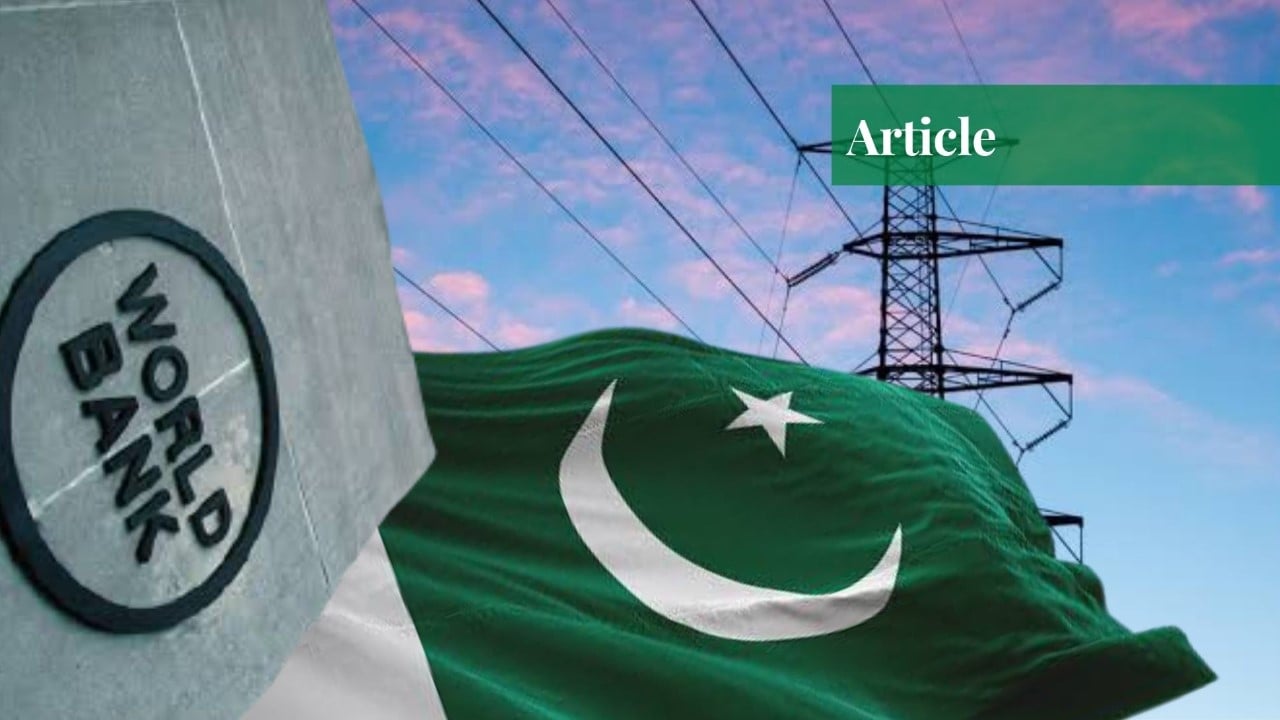
Written by Ayesha Zafar • December 28, 2021 • 12:00 pm • Articles , Current Affairs , Pakistan , Published Content • One Comment
Essay on Energy Crisis in Pakistan

Ms Ayesha Zafar is currently pursuing her Bachelor's in International Relations from National Defence University, Islamabad. She has authored multiple academic publications including research articles and book chapters. Her areas of interest include Middle Eastern politics, the geopolitics of Central Asia, and the Indo-Pacific region
- Ayesha Zafar https://www.paradigmshift.com.pk/author/ayesha-zafar/ The Digital Economy in the 21st Century: Blockchain for Real Estate
- Ayesha Zafar https://www.paradigmshift.com.pk/author/ayesha-zafar/ Pakistan Hosts the 2021 OIC Meeting on Afghanistan
- Ayesha Zafar https://www.paradigmshift.com.pk/author/ayesha-zafar/ German Chancellor Angela Merkel Says Farewell to Politics
- Ayesha Zafar https://www.paradigmshift.com.pk/author/ayesha-zafar/ President Biden’s Summit for Democracy 2021: A Big Question Mark?
- Ayesha Zafar https://www.paradigmshift.com.pk/author/ayesha-zafar/ The Ill-Fated Relationship Between Pakistan and the International Monetary Fund (IMF)
Causes of Energy Crisis: A Brief Overview
The global energy crisis, arising from a demand-supply imbalance exacerbated by natural disasters, political instability, economic growth, and technological changes, is currently intensified by the post-COVID-19 economic recovery, the war in Ukraine, and diverse weather conditions. This crisis is notably impactful in Pakistan, marked by electricity and oil and gas shortages, causing prolonged outages, disruptions, electricity theft, and price hikes.
The challenges in Pakistan involve population growth straining electricity demand, inadequate infrastructure, reliance on costly or insufficient fuel sources, and circular debts in the electricity sector. Political divisions impede crucial projects like dam construction, economic challenges hinder funding for new energy policies, and the neglect of cleaner energy sources worsens the country’s energy crisis issues.
Globally and locally, the energy crisis poses significant challenges, affecting economies, increasing poverty, and risking a global recession. Urgent interventions are essential to establish sustainable and reliable energy supplies, and for energy conservation.

The Constant Load Shedding
In this essay, the grave energy crisis in Pakistan will be discussed and analysed with relevant examples and statistics. Several factors have convulsed Pakistan with power shortages, and the most important among them is arguably rooted in deficiencies of governance rather than pure supply.
This complicated crisis, which has long been running, is not only instigating hiccups for consumers but also threatening the country’s economy and its precarious security situation. Thus, the World Bank expressed the need for reforms to increase electricity reliability and ensure cost-effectiveness.
According to the report published in 2018, Pakistan’s power sector caused a total of $18 billion or 6.5% of the GDP loss to the economy, in 2015. Nonetheless, effective and timely reforms could have saved $8.4 billion in business losses and increased household incomes by at least $4.5 billion a year, the report added.
Decisively, the Pakistan Economic Survey 2019–20 revealed that in the year 2020, Pakistan increased its installed electricity generation capacity up to 37,402 MW . However, only an estimated 73.91% of Pakistan’s population has access to electricity , whereas around 50 million people still lack access to grid electricity, according to the World Bank 2019 report.
World Bank & Its Possible Solutions for the Current Energy Crisis in Pakistan
To overcome Pakistan’s energy crisis, the World Bank’s Board of Executive Directors in June 2021 approved a total of $800 million in funding for two projects in Pakistan, namely the Pakistan Program for Affordable and Clean Energy (PACE) and Securing Human Investments to Foster Transformation (SHIFT). To get the best possible solutions to the energy crisis , Pakistanis need to understand what renewable energy is , what the potential is, what the challenges are, and what the best way forward for implementation is for local and international projects.
Worth $400 million, PACE will help Pakistan’s transition to low-carbon energy and introduce powerful reforms in the energy sector including subsidies for consumers. In this regard, Rikard Liden, task team leader for the PACE program stated, “Decarbonizing the energy mix will reduce the dependence on fossil fuel imports and vulnerability to price fluctuations because of movement in exchange rates. PACE prioritizes action on such reforms, which must be sustained to address circular debt and set the power sector on a sustainable path.”
On the other hand, SHIFT, which is worth another $400 million, intends to improve health and educational services while bringing the federal and provincial authorities on board. Altogether, these two initiatives by Pakistan in collaboration with the World Bank aim to empower the power sector for energy development.
Accusations Against the World Bank
Nevertheless, a recent report released by Recourse, a European think tank, has stunned not only Pakistani officials but has also raised multiple questions in the minds of the general public. According to the European think tank, the World Bank is the major reason behind Pakistan’s decades-long energy sector crisis.
In its report titled “World Bank’s Development Policy Finance (DPF) 2015–21: Stuck in a carbon rut,” the European think tank disclosed that its studies conducted in Indonesia and Pakistan have found the World Bank endorsing the use of natural gas and backing fragile energy sectors that are heavily invested in coal, instead of promoting renewable energy sources.
Emphasizing the need to have proper checks and balances, the think tank referred to the PACE program (2021-2022) that aims to ensure Pakistan’s transition to low-carbon energy. It stated in its report that, as per the agreement with the World Bank, the funding was subject to the condition that Pakistan’s authority would accomplish a 66% percent renewable energy target by 2030 by espousing a least-cost generation plan.
However, the targets for the energy sector have been slashed from 30-33 percent to nearly 17 percent , which will result in massive environmental degradation and resource exploitation. Outrageously, the year 2021 marks the second year of foundational reforms since Pakistan showed compliance to the World Bank’s ‘Prior Actions’ under Development Policy Finance (DPF) amounting to $1.4 billion.
IGCEP Power Plan Under Scrutiny
While questioning the reliability of the plan, the European think tank has blamed the World Bank’s DPF operation for its destabilizing effect on the ability of Pakistan to achieve the transition to a sustainable renewable energy conduit.
Not just this, another shocking news came as the think tank conversed about the pressure on the energy committee of Pakistan to approve the controversial Integrated Generation Capacity Enhancement Plan (IGCEP-2047) that the National Electric Power Regulatory Authority (NEPRA) vice-chairman refused to sign in the first place, keeping in view the reverberations it will yield later.

This political pressure to fast-track the IGCEP came back in August when Hartwig Schafer , vice-president of the World Bank, made his way to Pakistan and urged the government to take necessary actions to implement power sector reforms. In this regard, the Institute of Energy Economics and Financial Analysis (IEEFA), together with the Alliance for Climate Justice and Clean Energy, undertook a recent study that revealed the flaws and potential consequences of the IGCEP plan.
It stated in its report titled “Pakistan Risks Locking into Overcapacity and Expensive Power” that the “power demand growth forecasts made under the Integrated Generation Capacity Enhancement Plan-2047 [IGCEP-2047] are too high and do not take into account the impact of COVID-19.”
The study finds GDP growth to increase from 4% to 5.5% by 2025, yet the plan could make Pakistan stuck in overcapacity in the long run and upend sustainability and affordability as experienced by states like China, India, Indonesia, and Bangladesh since they overestimated consumer demands.
Notwithstanding the fact that the 5.3GW coal-fired power plants under IGCEP will be operationalized by 2030 and have a collective utilization of just 14%, they will make Pakistani coal plants stranded since functioning at such a low utilization rate is impossible. Thus, IGCEP’s patronage of expensive coal power plants for energy production over the much cheaper renewable energy resources indicates the failure of the plan to live up to the country’s affordability principle.
Prioritizing Action and Evaluation
In light of the fact that the World Bank’s “Priority Action” will make Pakistan suffer the most disparaging energy crisis in the long run, the essay recommends halting the enactment of the program as soon as possible. The energy demand, which is expected to quadruple in Pakistan in the coming years, will not only cause the consumer to undergo a grave energy crisis, worsening energy security, but will also bring massive pressure on the state to conciliate the demands of the people.
Therefore, this essay outlines important steps that have to be taken at the earliest to overcome the energy crisis in Pakistan. Pakistan must introduce power sector reforms that support a transition to renewable energy (solar energy, hydro power, etc.) and look for alternatives that would yield energy efficiency and protect the environment to a greater extent.
The time has come when the government has to work on red-tapism, corruption, and other constraints that are hindering foreign investment in the energy sector and should focus on institutional reforms that are much more desirable than ever. The government also needs to focus on encouraging organizations such as ezBike that are introducing electric vehicles in the country.
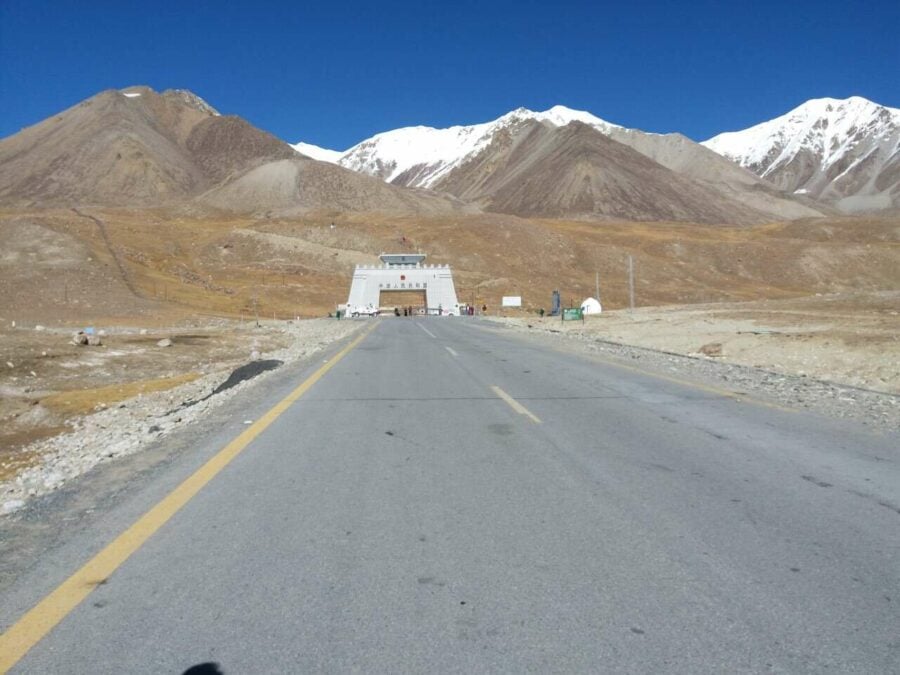
In this regard, the China-Pakistan Economic Corridor (CPEC), a flagship project, can prove phenomenal for the energy sector, as China stated during a meeting in Islamabad that it has so far invested around $12.4 billion in Pakistan’s energy sector, and a total of 12 power generation projects having the capacity to generate 7,240 MW of energy are either completed or in the construction phase as per the 2019 report.
Importantly, the installed electricity generation capacity was recorded at 34,282 Megawatts in Jul-Mar 2018-19 which is pretty encouraging for the energy sector. For that reason, CPEC is a golden opportunity for Pakistan to bring the country out of the energy crisis. To conclude this essay, Pakistan should take urgent action and ensure a fair investigation of the World Bank’s projects before the energy crisis becomes irreversible.
If you want to submit your articles and/or research papers, please check the Submissions page.
The views and opinions expressed in this article/paper are the author’s own and do not necessarily reflect the editorial position of Paradigm Shift .

Related Posts

Abdul Sattar Edhi: A Humanitarian Icon
Written by Mahira Saeed • September 6, 2024 • 8:06 pm •

Pakistan’s Cricket Team Needs Major Surgery after Poor Performance in T20 World Cup 2024
Written by Umer Naveed • September 4, 2024 • 6:32 pm •

A Comparative Analysis of the Electricity Prices in Pakistan, India & Bangladesh
Written by Hareem Amna • September 3, 2024 • 7:00 pm •

The Unending Balochistan Conflict
Written by Muhammad Karam • September 2, 2024 • 6:31 pm •
One Reply to “Essay on Energy Crisis in Pakistan”
Very interesting
FATIMA Fertilizer

Most Read – All Time

- Contributors
- Top Interns
- Terms of Service & Privacy Policy

Commentary from the Energy Security Program
Pakistan's energy crisis from conundrum to catastrophe.
An acute ongoing energy crisis poses serious threats to Pakistan’s feeble economy and national security environment. Michael Kugelman (Woodrow Wilson International Center for Scholars) examines the origins of the country’s energy problems, prevailing hurdles to reform, and potential impact of the upcoming general elections.
Pakistan’s acute energy crisis is posing a serious predicament for its feeble economy and volatile national security environment. The country’s energy problems are deep and complex, being rooted more in shortages of governance and political will than of pure supply. This stems from (1) the absence of a comprehensive and integrated energy strategy, resulting in interagency turf wars and a lack of coordination, (2) insufficient revenue to support energy generation and infrastructure, owing to low liquidity in Pakistan’s struggling economy and high rates of tax default, and (3) the leadership’s unwillingness to implement politically unpopular changes to address the situation.
Resolving Pakistan’s energy crisis will thus require political will, additional funding, and new power-generation sources. As the country lacks significant internal sources of revenue, opportunities exist for international donors to finance its energy recovery. The United States already provides a considerable amount of energy assistance to Pakistan, with Congress having released nearly $300 million in new energy aid last summer alone. However, indigenous energy solutions should not simply be discarded, and the Pakistani government should explore the Thar coalfields and alternative energy sources, among other options.
POLICY IMPLICATIONS
- Pakistan should consolidate its many energy-related institutions into a single ministry. This will bring some urgently needed order and efficiency to its dysfunctional energy sector.
A short-term fix that could bring immediate relief is to request a new loan from the International Monetary Fund (IMF). However, because the IMF would probably impose politically delicate conditions, Islamabad is unlikely to make such a request until after this spring’s elections.
Tax reform is imperative and should be designed to provide Islamabad with more revenue to address the energy crisis.
Pakistan can initially better diversify its energy mix by importing clean coal, which is often cheaper than imported oil and gas.
Pakistan will not be able to implement the reforms needed to resolve its energy crisis unless Pakistanis elect leaders this spring who genuinely desire to serve the interests of their country.
Pakistan’s Energy Crisis: From Conundrum to Catastrophe?
Pakistan is mired in an acute energy crisis—one with immense implications for both the nation’s floundering economy and its volatile security situation. According to some estimates, energy shortages have cost the country up to 4% of GDP over the past few years. They have also forced the closure of hundreds of factories (including more than five hundred alone in the industrial hub city of Faisalabad), paralyzing production and exacerbating unemployment. Additionally, they imperil much-needed investments in development and infrastructure. Meanwhile, the nation has been convulsed by energy riots. Protestors, angered by unscheduled outages, have often resorted to violence. They have blocked roads and attacked the homes and offices of members of both the ruling Pakistan Peoples Party and the Pakistan Muslim League, the chief opposition party. Significantly, in February 2013 Pakistan’s minister for water and power warned that the energy crisis has become a national security issue. For all these reasons, energy poses one of Pakistan’s most critical challenges.
Resolving this crisis will require far more than power-generation expansion and other supply-side quick fixes, the de facto policy of the country’s political leadership. Pakistan’s energy problems are deep and complex, and are rooted more in shortages of governance and political will than of pure supply. If the nation is to overcome this crisis, it will need to begin with whole-scale institutional energy sector reform—a politically unwelcome, yet utterly essential, prerequisite for energy relief. Necessary reforms can then follow. The success of such efforts, however, will hinge on the existence of leaders willing to prioritize long-term national development and well-being over short-term political considerations.
Origins and Nature of the Current Crisis
The origins of Pakistan’s energy crisis can be traced back to the 1990s. A major energy crisis was actually averted in the 1970s, when the government launched the massive Mangla and Tarbela dams, leading to a short-lived period of robust hydro-driven energy generation that ably responded to demand. However, after a period of strong economic growth in the 1980s, energy demand soared, and supply and infrastructure could not keep up. The government sought to ramp up generation but was unable to satisfy demand. As Pakistan’s population has risen, and as urbanization has spawned the rise of new industries and other corporate energy customers, the situation has continued to worsen to the present day. Electricity shortfalls reached a peak of 8,500 megawatts (MW) in June 2012—more than 40% of national demand.
With this in mind, it is important to emphasize that Pakistan’s current energy quandary is rooted in paucities that go well beyond those of power supply. In fact, Pakistan is blessed with ample indigenous energy resources; it is especially rich in natural gas, hydroelectricity, and coal. However, in the case of the two most utilized sources of energy—oil and gas—consumption levels are so high that these domestic resources are being rapidly depleted. Pakistan’s national oil and gas company, Oil and Gas Development Company Limited (OGDCL), predicts indigenous oil reserves will be exhausted by 2025, and that Pakistan will run out of domestic sources of natural gas by 2030. Meanwhile, hydroelectricity supply is imperiled by climate change, with less rainfall reducing river flows.
At the same time, governance shortfalls (and not just of the corruption variety) are a key challenge for the power sector. Pakistan’s energy policies come under the purview of several government ministries and agencies, but coordination is lacking, clear lines of authority are absent, and interagency turf wars are legion. The sector also suffers from gross inefficiencies (including 30% transmission and distribution losses), and electricity theft is rife; Pakistanis can regularly be seen hooking onto power lines.
Yet one of the most critical deficiencies plaguing the energy sector is money. With Pakistan’s economy struggling, liquidity is dangerously low. In effect, energy consumers, private producers, the national transmission agency, distribution companies, and even the government itself cannot pay their power bills. Of note, according to figures provided by Pakistan’s water and power ministry, “influential defaulters” owe about $1 billion in overdue energy bills. As a result, the energy sector is deprived of desperately needed revenue to pay for generation, transmission, and distribution, as well as operating and administrative costs. This gap between revenue and expenses—often referred to as “circular debt”—has approached a whopping $4.5 billion and is worsened by the fact that, thanks to generous government-funded subsidies, energy end-costs for consumers are always lower than the actual cost of production. Consequently, the country cannot afford to provide a regular supply of power.
A Lack of Strategy and Political Will
A subset of the energy financing problem is an inability or unwillingness to muster the necessary political will to address the money shortage. More broadly, Pakistan has never developed a comprehensive, integrated energy strategy, and Islamabad’s haphazard policies have failed to address the crisis’s deep roots. The problem lies not with civil servants, bureaucrats, and technical experts who focus on developing energy policies (many of them reasonable and actionable), but rather with the non-expert, high-level political appointees spread across the energy sector and beyond who are charged with implementing them.
Pakistan announced a national energy plan in 2010, though it was dominated by much-mocked—and likely ignored—conservation measures, such as bans on all-night wedding parties and neon billboards, along with the required early closures of street markets. (A more realistic demand-management strategy, announced last year by the Asian Development Bank, calls for the distribution of twenty million low-energy light bulbs.) Other well-intentioned initiatives have likewise not produced results. Pakistan has established the National Electric Power Regulatory Authority (NEPRA), charged with ensuring fair energy competition and consumer protection, but political interference undermines its autonomy and effectiveness. Tariff decisions must be approved by Islamabad, and NEPRA’s four members are all selected by the government. Furthermore, government officials have been known to outright ignore the body’s decisions.
Recent recommendations put forth by Pakistan’s Planning Commission, however, offer some hope. In 2011, the commission released what it described as a “new framework” for economic growth, which calls for more focus on the private sector, cities, and youth. If implemented, the impact would be immense, as the plan would represent a paradigm shift in Pakistan’s development philosophy.
In the context of energy, the document proposes some of the most far-reaching and comprehensive policy measures ever introduced in Pakistan—from full-scale sectoral deregulation to governance reform and the phasing out of many subsidies. Unfortunately, there are several problems. One is that while the Planning Commission is part of the government, it lacks implementation power, and no government entity has stepped up to embrace the commission’s ideas and take on the mantle of implementation. (In fact, government agencies often spar with the Planning Commission.) Another dilemma is that the Planning Commission insists that such measures are only implementable after the country has established an integrated energy policy, which has still not happened. Moreover, Islamabad likely has little desire to authorize the Planning Commission’s measures anyway, given that some of them (such as phasing out subsidies) are fraught with political risk—especially with national elections scheduled for spring 2013. On the subsidy question, in particular, while many experts accurately note that Islamabad’s policies distort pricing, these measures are unlikely to change for political (and not systemic) reasons. This is because subsidies provide temporary relief to an impoverished mass population that often harbors antigovernment sentiment. It also bears mentioning that reducing subsidies could have an unintended effect: increasing the number of Pakistanis who do not pay their taxes (given that if the poor are asked to pay more for energy, they may not have enough money to pay their taxes).
Yet herein lies a major dilemma, because Pakistan’s government would significantly increase its revenue—and hence its ability to pay its energy bills—if more of the country paid its taxes. Former U.S. secretary of state Hillary Clinton has claimed that only 2 million of Pakistan’s population of 180 million pay income taxes, while Pakistan’s Federal Board of Revenue estimates that 700,000 wealthy Pakistanis are not paying their returns. The latter figure, in particular, suggests that revenue gains from increasing the number of citizens paying taxes could be tremendous. However, the government refuses to pressure its most affluent citizens, because many of them are politically connected or politicians themselves. And admittedly, there is no guarantee that Islamabad would actually use this added tax revenue to cover its energy debt; it could well spend the revenue on the repayment of other debts, administrative costs, or even defense.
Scenarios for the Future
Given that Pakistan lacks the revenue to finance an energy recovery, future opportunities abound for international donors, including the United States. Washington, in fact, already provides a considerable amount of energy assistance to Pakistan. The Obama administration identifies energy as a priority area in its civilian assistance program to the country, and Congress released nearly $300 million in new energy aid last summer alone. The U.S. private sector also contributes to Pakistan’s energy sector, including in overtly political ways. Last summer, ConocoPhillips mediated talks between Pakistan and Qatar on a potential natural gas deal in an effort to discourage Islamabad from pursuing a pipeline project with Iran that is opposed by Washington.
Given the extent of Pakistan’s energy woes, and especially its circular debt—which, at its highest point of nearly $4.5 billion, far exceeded the value of Washington’s $1.5 billion in total annual civil assistance—it is folly to expect U.S. energy aid to make a major dent in the crisis. Conversely, if U.S. civilian assistance to Pakistan were to be cut, the reduction of energy-intensive aid would be a significant loss for the country. This assistance includes a USAID infrastructure project, expected to be completed by this year, which adds nearly 1,000 MW to the national power grid—a fifth of Pakistan’s energy shortfall.
This is not to say that indigenous solutions should simply be discarded. Consider the vast Thar coalfields in Sindh Province, where 200 billion tons of reserves have lay dormant since their discovery more than twenty years ago (Thar constitutes the world’s sixth-largest coal deposit). Last year, Islamabad designated Thar as a special economic zone, hoping to lure investors with tax breaks and other incentives. Some, however, believe that the government must be more aggressive. Thar has been a common theme on the campaign trail for this year’s elections, with opposition parties hailing Thar as an elixir for Pakistan’s energy supply crunch and underscoring the urgency of tapping into its riches.
However, what both the government and political opposition fail to articulate is how Pakistan will overcome the formidable challenge of developing the technological and labor capacity to exploit this potential bonanza. Another problem is purely political. Ever since the Thar coal was discovered, the central government has been locked in a disagreement with the Sindh provincial government about how to divvy up the spoils. Islamabad has proposed an 80/20 split, while Sindh has insisted that it retain full control of the coalfields. This 22-year-old disagreement has effectively put on hold the exploitation of Thar’s resource treasures and crystallizes how Pakistan’s energy woes are as much (if not more) a governance and political issue as one of supply and demand.
Encouragingly, Pakistan is also starting to explore other alternative energy sources. Officials have said several small-scale wind projects are under construction. The government has also announced that by 2030 it plans to have a minimum of 5.0% of total commercial energy supply provided by wind, solar, and biowaste, and that 2.5% of Pakistan’s overall energy generation will come from renewables. Islamabad claims that by 2030 about 5,500 MW of Pakistan’s projected 160,000-MW daily energy requirement will come from alternative and renewable sources. These are admittedly ambitious goals, given the miniscule role renewables play in the current energy mix.
Ultimately, it is the issue of implementation that prolongs Pakistan’s energy crisis, making many experts pessimistic that the crisis can be resolved anytime soon. There is no shortage of research, conferences, and proposals offering policy solutions. However, these measures are not executed, because there is no political will to do so. This has long been the case at both federal and provincial levels, as well as with different political parties. While the ruling Pakistan Peoples Party has been the political face of the energy crisis since 2008, the previous government (led by Pervez Musharraf and the Pakistan Muslim League Quaid-e-Azam, or PML-Q) largely restricted its energy policies to supply-generation measures—the same politically safe bets made today. Then, as now, few efforts were made to strengthen energy governance or reform the energy pricing system. Tellingly, even in the rare cases when the government enacts politically risky measures to strengthen the energy sector and overall economy, it often reverses course. In 2011, for example, Islamabad repealed an increase in fuel prices—instituted to raise desperately needed revenue—after a key coalition partner had withdrawn from the government to protest this price hike.
The Clock Is Ticking
With no end in sight, the implications of Pakistan’s energy crisis are stark and go well beyond threats to the country’s economic well-being and stability. Pakistan is currently in the midst of two major societal shifts that could worsen the effects of its energy problems in the years ahead. One is urbanization. While today the majority of Pakistan’s population is rural, estimates suggest that at least 50% could be concentrated in urban areas by the 2020s. Demand for electricity is particularly high in cities, because urban-area industries and homes tend to be more dependent than those in the hinterland on grid-connected energy sources. With droves of Pakistanis entering cities and becoming dependent on grids, pressures on supply will deepen exponentially.
Pakistan’s other notable societal shift that could worsen the energy crisis is the devolution of governance from the federal level to the provincial and local levels. Thanks to the 18th constitutional amendment, which President Asif Ali Zardari signed in 2010, federal ministerial responsibilities and resources are being passed down to local authorities and agencies. This means that many new energy-related functions and duties are being foisted upon provincial and district governments, which suffer from even more capacity constraints, inefficiencies, and financial troubles than their federal counterpart. Local governments will likely inherit the ineffective policies of the federal government as well. Given the central government’s inability to address the country’s energy crisis, there is even less reason to expect that short-handed local-level authorities are up to the task.
How long can Pakistan ride out this storm? Today, many Pakistanis are getting by through their own resourcefulness, as they do on so many occasions when their government fails to provide basic services. This winter, some residents have coped with the nation’s worst gas shortage on record by fashioning homemade pumps from old refrigerators and sucking gas out of distribution systems. Others have done their cooking only when gas stations are closed—the only time they receive any pressure.
Time is running out, however. Pakistan faces rapidly dwindling foreign reserves and a plunging currency that late last year fell to a record low, and double-digit inflation is projected to hit this year. There is the very real fear that Pakistan could soon find itself unable to afford to address its energy crisis—meaning that even stopgap, short-term measures to expand power generation could be eliminated. Such a scenario would presumably increase the frequency and violence of public protests and threaten the state’s ability to maintain order. The consequences could be catastrophic for the country’s economy and stability.
Recommendations and Conclusions
There are some short-term steps that Pakistan can and should take. One is to formally request a new loan from the International Monetary Fund (IMF) to bring both immediate relief to the economy and badly needed liquidity to finance solutions to the energy crisis. However, given that the IMF would probably impose politically delicate conditions—including the phasing out of some energy subsidies—Islamabad is unlikely to make such a request until after this year’s election. Even if the next government follows through, another loan would simply be another short-term fix.
Above all, Pakistan must bring some urgently needed order and efficiency to its chaotic and dysfunctional energy sector. A better coordinated and integrated energy sector can best be attained through the consolidation of the country’s many energy-related institutions into a single ministry. A tighter institutional set-up would allow Pakistan’s energy sector to enjoy better coordination of planning, decision-making, and above all implementation. This would in turn enable it to do away with the reactive, haphazard, and ad-hoc policy environment that has characterized the energy sector for years. Although such a transformation will certainly be difficult to achieve, the seeds have already been planted. Back in the early 1980s, Pakistan experimented with establishing a more coordinated system, but those efforts petered out due to capacity constraints. Today, some influential players in the energy scene—including policymakers—have indicated their support for revisiting the idea. After a new institutional arrangement is in place, Pakistan could move on to policy reform. This should include new pricing measures that remove not all, but many, energy subsidies. Tax reform is another imperative—and should be designed to provide Islamabad with more revenue not just to address the energy crisis but also to assist poor Pakistanis harmed by the phase-out of subsidies.
Pakistan should also make improvements on the energy-demand side—such as by aiming to reduce by half the 30% in losses arising from distribution and transmission (a goal that will entail crackdowns on energy theft). Both federal and provincial authorities should be more vigilant about keeping up with necessary maintenance and repairs at all generation, distribution, and transmission facilities in order to minimize leakage and other losses. Any efforts to improve energy governance will need to occur in tandem with measures to curb wasteful water consumption. Decades of water-intensive agricultural practices—including widespread and subsidized flood irrigation—have helped deplete surface water tables and prompted farmers to expend excessive electricity on tubewells to extract groundwater.
Finally, Pakistan should better diversify its energy mix. This can be done initially by importing clean coal, which is often cheaper than imported oil and gas. With time, if the political spats over Thar’s reserves can be worked out, then the nation would ideally begin to focus on developing indigenous supplies—though a variety of challenges, such as transporting the coal across the nation and overcoming possible resistance to environmental costs, would remain. Pakistan is already making an effort to diversify by pursuing separate pipeline projects with Iran and with Turkmenistan, Afghanistan, and India. However, a variety of factors (international sanctions–based with the former, and security-oriented with the latter) suggest that these projects are far from being consummated. In the meantime, Pakistan should take advantage of its enhanced commercial relationship with India to import energy from that country. Already, the two nations have concluded a deal to export electricity to Pakistan, and they have created a joint working group on petroleum to explore further possibilities for energy trade. Hypothetically, Pakistan-India energy trade could be expanded to feature more region-wide energy commerce, with organizations such as the South Asia Association for Regional Cooperation (SAARC) providing an institutional platform. However, the fractious political relations between South Asia’s states make this prospect unlikely in the near term.
Ultimately, there is just one obstacle to the implementation of these measures, and that is leadership. For years, Pakistani officials have had promising policies at their disposal; yet they have been unwilling or unable to move forward. This spring, if Pakistanis elect leaders with a genuine desire to serve the interests of their country, then the end of its long energy struggles could conceivably be in sight. Yet if the election produces another governing dispensation concerned only about its own interests and political survival, then Pakistan’s energy conundrum could well become an energy catastrophe.
[1] Annabel Symington, “Pakistan Opposition Take Aim at Energy Crisis Ahead of Elections,” Christian Science Monitor , February 1, 2013, http://www.csmonitor.com/World/Asia-South-Central/2013/0201/Pakistan-opposition-take-aim-at-energy-crisis-ahead-of-elections ; and “Pakistan’s Energy Shortage: Lights Out,” Economist , October 8, 2011, http://www.economist.com/node/21531495 .
[2] “Electricity Shortfall in the Country Reaches 8,500 MW,” Dawn, June 17, 2012, http://dawn.com/2012/06/17/residents-protest-prolonged-loadshedding-in-lahore ; and “Pakistan’s Energy Crisis: Power Politics,” Economist, Banyan Asia, web log, May 21, 2012, http://www.economist.com/blogs/banyan/2012/05/pakistan’s-energy-crisis .
[3] Saleem Shaikh and Sughra Tunio, “Pakistan to Boost Renewable Energy to Meet Power Shortfall,” AlertNet, July 6, 2011, http://www.trust.org/alertnet/news/pakistan-to-boost-renewable-energy-to-meet-power-shortfall .
[4] Jon Boone, “Pakistan Power Cut Riots Spread as Politician’s House Stormed,” Guardian, June 19, 2012, http://www.guardian.co.uk/world/2012/jun/19/pakistan-power-cut-riots .
[5] “For Pakistan, Everyday is a Blackout with No End in Sight,” Agence France-Presse (AFP), August 8, 2012, available at http://dawn.com/2012/08/08/for-pakistan-everyday-is-a-blackout-with-no-end-in-sight .
[6] Indira A.R. Lakshmanan, “Clinton Criticizes Low Rate of Tax Collection in Pakistan,” Bloomberg, October 21, 2011, http://www.bloomberg.com/news/2011-10-21/clinton-criticizes-low-rate-of-tax-collection-in-pakistan.html ; and Mehreen Khan, “Energy Subsidies Dilemma Expose Failings of Pakistan State,” Financial Times , Energy Source, web log, August 5, 2011, http://blogs.ft.com/energy-source/2011/08/05/energy-subsidies-dilemma-expose-failings-of-pakistan-state .
[7] “”No End in Sight for Pakistan’s Energy Crisis,” AFP, August 8, 2012, available at http://tribune.com.pk/story/419175/no-end-in-sight-for-pakistans-energy-crisis ; and “Aid to Pakistan by the Numbers: What the United States Spends in Pakistan,” Center for Global Development, Study Group on a U.S. Development Strategy in Pakistan, http://www.cgdev.org/section/initiatives/_active/pakistan/numbers .
[8] Shaikh and Tunio, “Pakistan to Boost Renewable Energy.”
[9] Shahid Javed Burki, “Historical Trends in Pakistan’s Demographics and Population Policy,” in Reaping the Dividend: Overcoming Pakistan’s Demographic Challenges, ed. Michael Kugelman and Robert M. Hathaway (Washington, D.C.: Woodrow Wilson International Center for Scholars, 2011), 67.
[10] “IMF Warns of Deteriorating Pakistan Economy,” AFP, October 5, 2012, available at http://tribune.com.pk/story/447222/imf-warns-of-deteriorating-pakistan-economy .
Michael Kugelman is the Senior Program Associate for South Asia at the Woodrow Wilson International Center for Scholars in Washington, D.C.
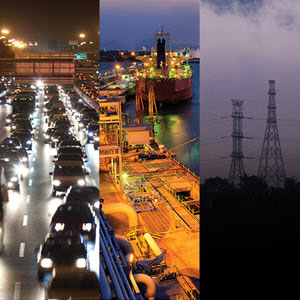
- national security
- Privacy Policy
- Our Authors
- Subscribe Us
- Google Plus

Essay Outline: Energy Crisis in Pakistan: Consequences and Recommendations
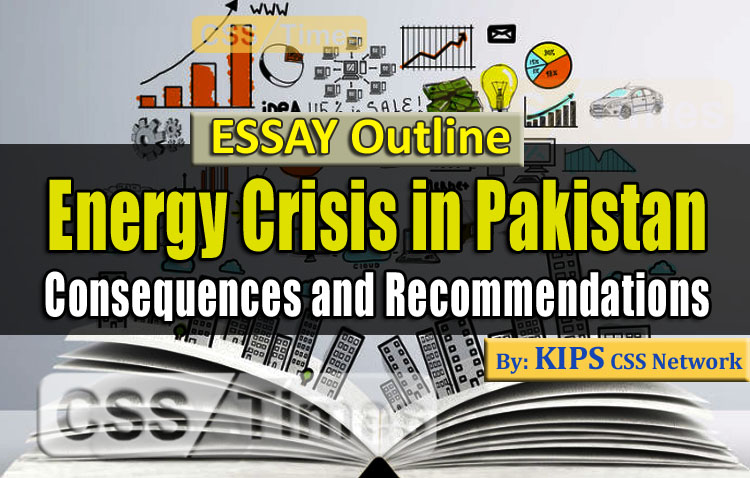
Table of Contents
1. Introduction
1.1 Energy as lifeline in modern countries 1.2 Brief review of international research on Pakistan’ energy crisis
2. Pakistan’s Energy Scenario
2.1 Energy Supply (94.65 kwh) 2.2 Energy consumption (70.1 kwh) (per capita 357.34 kwh)
3. Sources of energy Procurement in Pakistan
3.1 Non-Renewable Energy Sources and Current Projects 3.2 Renewable Energy Sources 3.3 Alternative energy Sources
Check Also: Essay Outline: Impacts of Climate Change on Pakistan as One of the Worst Hit Regions
4. Issues Faced by Energy Sector
4.1 Policy Issues a) Adhoc policies and decisions (not goal oriented) b) Inadequate Institutional arrangement/Absence of single institution to monitor supply companies c) Shift towards expensive and unstable Thermal Energy d) Oil used for power generation e) Independent Power Plants (IPPs) and Rental Power Plants f) Provision of subsidiesed electricity to WAPDA & agricultural tube wells g) Lesser utilization of Thar coal and hydel power generation
4.2 Governance and Management Issues a) Poor governance by public and private sectors b) Power theft (line losses) c) Default in revenue recovery by public and private sectors d) Weak Regulatory body: NEPRA e) Politicization of mega projects: Kalabagh Dam
4.3 Technical Issues a) Inadequate maintenance and repair of power plants b) Dilapidated Transmission and distribution systems c) Imbalanced and imported resources based energy mix
4.4 Cost Issues a) Unaffordable and unsustainable energy
Check Also: Essay Outline: Disturbed Borders Suggest Unending Wars and Threats to Human Lives
5. Consequences of Energy Crisis
5.1 Economic Factors a) Closure of industries b) Flight of capital to overseas domains c) Shrinking Foreign Direct Investment (FDI) 5.2 Agricultural sector 5.3 Industrial sector 5.4 Social Factors a) Poverty and unemployment b) Destabilized health sector c) Chaos in society and political uncertainty d) Public trust erosion
Check Also: Essay Outline: Economic Crisis in Pakistan: Challenges and Prospects
6. Recommendations
6.1 Short Term Measures (Within 6 months to 1 year) a) Resolution of circular debt b) Prompt implementation of NEPRA determined Tariffs c) Ensuring recovery of revenues from public sector d) Crackdown on energy/electricity theft e) Judicious energy usage and use of electricity saving devices f) Energy conservation campaigns and demand management g) Fostering niche markets for early commercialization of technologies
6.2 Medium Term Measures (within the next 5 years) a) Development of an integrated energy policy b) Allotment of funds to GENCOs for refurbishment of plants and transmission systems c) Promotion of renewable energy at household level and in off-grid remote areas d) Move to decentralized and distributed energy generation f) Utilization of copper transmission wires for rectifying line losses
6.3 Long Term Measures (within the next 10 years & beyond) a) Correction of the energy mix imbalance b) Improvement in governance and elimination of corruption c) Import of energy from Tajikistan through TAPI pipeline d) Establishment of alternative energy and power research development and testing facilities e) Development of global alliances to secure dependable supply chain relationships f) Adoption of environmentally suitable energy policies g) Enhance market potential and viability for international investors h) Tactful utilization of Pakistan’s geostrategic location by serving as an energy corridor i) Population control to decrease growing demand * Wilson Institute and Michael Kugelman’s reports on Energy Crisis in Pakistan j) Construction of hydel dams at strategic locations
Check Also: Essay Outline | Flaws in Our Education System are Causing Some of Our Failures
About the author
KIPS CSS Network
You may also like.

Essay Outline: Electoral Reforms in Pakistan:...

Health for All | Essay Outline for CSS PMS


Exploring the Economic Potential of BRICS Countries:...

Art and Morality Essay Outline

Instruction in Youth is Like Engraving in Stone |...

Public Office is a Public Trust | Complete CSS Essay
Leave a comment x.
Error in downloading
[…] Check Also: Essay Outline: Energy Crisis in Pakistan: Consequences and Recommendations […]
- Introduction
- Director General
- About the Journal
- Aim & Scope of the Journal
- Editorial Team
- Editorial Advisory Board & Editorial Board
- Journal’s Archive
- Review and Publication Guidelines
- Ethical Guidelines
- Plagiarism Guidelines
- Indexing & Abstracting
- Call for Papers
- Issue Briefs
- Special Guest Articles
- Tuesday Dialogue
- Conference Reports
- Combating Corona
- Islamabad Papers
- Young ISSI Professionals Corner
- Annual Reports
- Vision & Functions
- Advisory Board – China Pakistan Study Centre (CPSC)
- Pivot Magazine
- CPSC Monitor
- ACDC Vision
- ACDC Functions
- News & Views
- ISC Functions
- ISC Monitor
- CAMEA Vision
- CAMEA Functions
- CAMEA Bulletin
- CSP Functions
- ISSI Library
- HEC Digital Library
- Events Archive
- Upcoming Events
- Press Releases

Book Launch on “CHEENI SAQAFAT KAY TABINDA NUQOOSH”

Thought Leaders Forum on “Buddhist Heritage of Pakistan: A Bridge to…

Seminar on “Unlocking the Potential of Blue Economy and Pakistan’s National…

Book Launch “Return of the Taliban: International & Regional Perspectives”

Press Release – ISSI hosts Seminar on “Artificial Intelligence and National…

پریس ریلیز: آئی ایس ایس آئی نے یوم دفاع کی یاد…

Press Release – ISSI Commemorates Defence Day

پریس ریلیز : آئی ایس ایس آئی اور نیشنل انسٹی ٹیوٹ…

Press Release – ISSI and NIMA jointly organize Seminar on “Unlocking…
- ISSI Publications Articles
Issue Brief on “Pakistan’s Energy Crisis: The Need for a Transition to Alternate Energy”
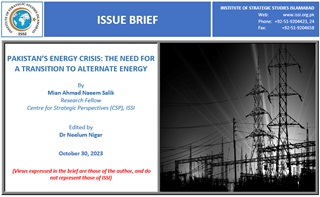
Like many other developing countries, Pakistan has been grappling with a severe energy crisis for several years. The demand for energy continues to surge due to population growth, urbanization, and industrialization, while the supply of conventional energy sources remains inadequate. This energy deficit has led to frequent power outages, hampering economic growth, disrupting daily life, and impeding technological progress. In this context, the adoption of alternative energy sources presents a compelling solution to address Pakistan’s energy crisis. [1] Pakistan’s energy crisis is a long-standing and multifaceted issue that has significantly impeded the country’s economic growth and development. Pakistan witnessed acute energy crisis during the summer months from May-August 2023. The electricity shortfall widened to 7,000 megawatts with demand rising to 28,200 megawatts, while the power supply was 21,200 megawatts. [2]
RELATED ARTICLES MORE FROM AUTHOR

Issue Brief on “Modi’s Ukraine Visit: Strategic Autonomy or a Thinly Veiled Diplomatic Charade?”

Issue Brief on “India Nuclear Black Market”

Issue Brief on “Deadly Heatwaves in Pakistan and the Role of Urban Planning”
Recent publications.
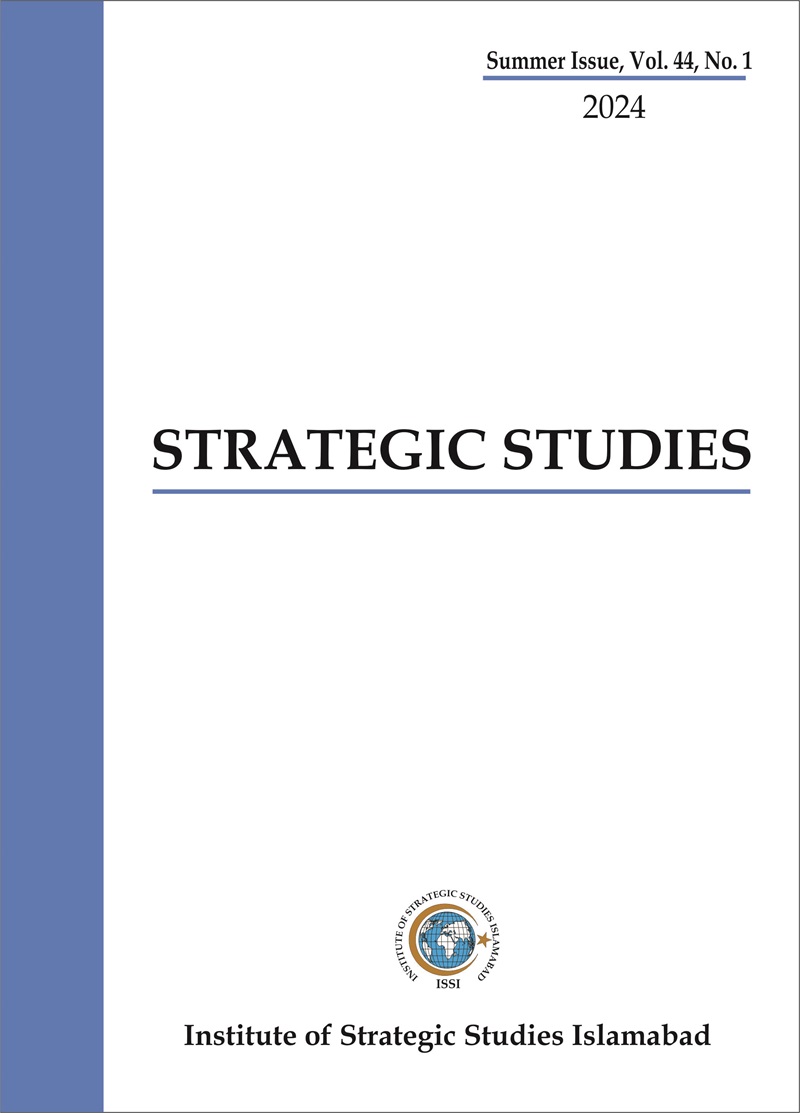
Strategic Studies (Vol. 44, Summer 2024, No. 1)

Strategic Studies (Vol. 43, Winter 2023, No. 2)

Strategic Studies (Vol. 43, Summer 2023, No. 1)

Strategic Studies (Vol. 42, Winter 2022, No. 2)

Strategic Studies (Vol. 42, Summer 2022, No. 1)
- Foreign Affairs
- CFR Education
- Newsletters
Climate Change
Global Climate Agreements: Successes and Failures
Backgrounder by Lindsay Maizland December 5, 2023 Renewing America
- Defense & Security
- Diplomacy & International Institutions
- Energy & Environment
- Human Rights
- Politics & Government
- Social Issues
Myanmar’s Troubled History
Backgrounder by Lindsay Maizland January 31, 2022
- Europe & Eurasia
- Global Commons
- Middle East & North Africa
- Sub-Saharan Africa
How Tobacco Laws Could Help Close the Racial Gap on Cancer
Interactive by Olivia Angelino, Thomas J. Bollyky , Elle Ruggiero and Isabella Turilli February 1, 2023 Global Health Program
- Backgrounders
- Special Projects
United States

Book by Max Boot September 10, 2024
- Centers & Programs
- Books & Reports
- Independent Task Force Program
- Fellowships
Oil and Petroleum Products
Academic Webinar: The Geopolitics of Oil
Webinar with Carolyn Kissane and Irina A. Faskianos April 12, 2023
- Students and Educators
- State & Local Officials
- Religion Leaders
- Local Journalists
NATO's Future: Enlarged and More European?
Virtual Event with Emma M. Ashford, Michael R. Carpenter, Camille Grand, Thomas Wright, Liana Fix and Charles A. Kupchan June 25, 2024 Europe Program
- Lectureship Series
- Webinars & Conference Calls
- Member Login
What’s at Stake in Pakistan’s Power Crisis
By Noah Berman
February 6, 2023 3:00 pm (EST)
Worsening blackouts are the latest manifestation of Pakistan’s economic distress. A brewing debt crisis could plunge the country into financial chaos.
A wave of darkness engulfed Pakistan on January 24 as its aging power grid strained to meet the country's demand for electricity. The massive outage was the latest in a series of blackouts that have become a chronic symptom of Pakistan’s ailing and climate-vulnerable economy, under duress from devastating natural disasters, a colossal debt load, and the mounting risk of sovereign default. With Islamabad rushing to negotiate a bailout from the International Monetary Fund (IMF), experts fear the response will not be enough to avoid a crisis.
What caused the January power outages?
Local officials blamed a surge in voltage at a power station in Sindh Province that cascaded throughout the country, bringing down the grid and leaving more than two hundred million people without power for nearly a day.
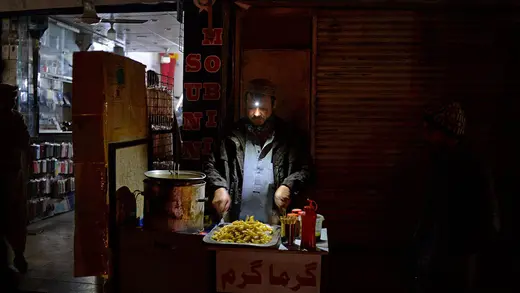
Such blackouts are becoming increasingly common. Analysts say the electricity grid, established prior to Pakistan’s 1947 independence and largely constructed in the 1960s, is suffering from a dangerous lack of maintenance and investment. Pakistan is also running low on the imported fossil fuels that power the grid, with prices skyrocketing since the Russian invasion of Ukraine began.
Energy and Climate Security
International Monetary Fund (IMF)
“Given how rickety and dilapidated the electricity grid is, and the associated infrastructure, it doesn’t take all that much to deliver a catastrophic shock to the system,” says Michael Kugelman, a South Asia expert at the Wilson Center.
What’s at stake if the power outages continue?
Pakistan’s electricity woes have added to the country’s precarious financial dilemma, with the blackout inflicting an estimated $70 million loss to the country’s textile industry, its largest export sector by a wide margin. Meanwhile, Islamabad’s total national debt had soared to over $200 billion [PDF] by late 2022, amounting to roughly 90 percent of its gross domestic product (GDP), according to state bank statistics. A series of compounding factors have shaken Pakistan’s economy: double-digit inflation has made everyday goods such as food and fuel more expensive, and interest rate hikes by the U.S. Federal Reserve and other central banks have resulted in rapid devaluation of Pakistan’s currency, the rupee. Meanwhile, an estimated $40 billion in damage caused by last year’s catastrophic flooding , a budget deficit worsened by large government subsidies, and an unforgiving debt load have brought the country to the precipice of default.
The World This Week
A weekly digest of the latest from cfr on the biggest foreign policy stories of the week, featuring briefs, opinions, and explainers. every friday., daily news brief, a summary of global news developments with cfr analysis delivered to your inbox each morning. weekdays., think global health.
A curation of original analyses, data visualizations, and commentaries, examining the debates and efforts to improve health worldwide. Weekly.
Last week’s blackout aggravated this economic adversity. Extended power outages could also affect Pakistan’s agriculture industry and force the country to import more food, a troubling prospect given that the prices of staples such as grain and vegetable oil have soared in the past year. Though Pakistan has been a net importer of food for much of the past three decades , its reliance on food imports surged last summer, when floods destroyed millions of hectares of farmland.
“If these power outages and these broader electricity problems continue over time, you’re going to see major deleterious implications for the economy, both right away and further down the road,” Kugelman says.
What do Pakistan’s struggles mean for other countries?
An economic crisis in Pakistan could have implications for Islamabad’s close relationships with Washington and Beijing. Meanwhile, its growing climate disruptions could ring alarm bells for other vulnerable countries.
Beijing has invested over $60 billion in the country via its Belt and Road Initiative (BRI), through both debt and equity financing; Pakistan has borrowed $30 billion from Chinese lenders. While China has already reduced its lending to Pakistan, analysts say a sustained crisis could make Beijing wary of investing more money in the country. And default in another BRI country—Sri Lanka and Ghana both defaulted in 2022—could resurface other lenders’ concerns about China’s notorious reluctance to take losses on its loans. Pakistan borrowed more from China than Sri Lanka or Ghana did, so another round of contentious debt negotiations could raise questions about Beijing’s leverage over countries that owe it money. A default could also give pause to other countries considering Chinese investment.
“Chinese state banks have been acting like most commercial creditors—they seem determined to get their money back with interest as quickly as possible,” says CFR’s Brad Setser.
The United States has sought to bolster Pakistan as a stable partner in a region stricken by terrorism and violence, providing tens of billions of dollars in military aid and other assistance over the past two decades. With Pakistan and other climate-vulnerable countries suffering increasingly severe economic consequences from climate change, many experts say what’s needed now is aid tied to climate adaptation. However, some of them argue that the $200 million Washington has provided to Islamabad since summer 2022 barely registers in terms of Pakistan’s need. That paucity of aid could portend lackluster financial support from wealthy nations for climate adaptation policies in other low-income and climate-vulnerable countries.
Will an IMF bailout stave off an economic crisis?
Pakistan hopes to forestall default by unlocking a paused $1.1 billion disbursement from the International Monetary Fund, the world’s controversial financial firefighter . Islamabad has implemented a series of reforms aimed at complying with the lender’s conditions, including hiking fuel prices and instituting a market-based exchange rate for the rupee. The funding is part of a $7 billion bailout that Pakistan and the IMF agreed to in 2019, their fifth such deal in the past two decades.
What would be coming from the IMF would be a drop in the bucket.
IMF conditions have often proved unpopular in Pakistan, and Prime Minister Imran Khan imposed subsidies that derailed the country’s IMF program before he was ousted from office last year. With the rupee falling to an all time low, imports, especially fuel, have become much more expensive, and officials worry about how the country’s forty-six million poor people will survive the spike in prices.
But even Khan has now said the country has “no choice” but to negotiate with the IMF. To stay afloat, Pakistan has drained its foreign reserves: as of early February, the country’s remaining $3.7 billion in central bank reserves were enough for only three weeks of imports. Meanwhile, double-digit inflation has made looming debt payments increasingly out of reach.
Even so, some analysts say that the proposed bailout would be little more than a band-aid solution given the country’s massive debt burden and debilitating underinvestment in electricity and other infrastructure.
“If you’re looking at the scale of the financial needs within the electricity sector, and the broader energy sector, what would be coming from the IMF would be a drop in the bucket in terms of what’s needed more broadly,” Kugelman says.
Explore More on Pakistan
The President’s Inbox Recap: Pakistan in Crisis
Blog Post by Michelle Kurilla May 25, 2023 The Water's Edge
In Brief by Noah Berman February 6, 2023
Increasing U.S. Aid to Pakistan Is a Strategic and Moral Imperative
Blog Post by Andrew Gordan November 17, 2022 Asia Unbound
Top Stories on CFR
Blocking the Nippon Steel Acquisition: Politics Versus Policy
Article by Matthew P. Goodman September 11, 2024 RealEcon
Ronald Reagan on U.S. Global Leadership, with Max Boot
Podcast with James M. Lindsay and Max Boot September 10, 2024 The President’s Inbox
From the Ukraine Conflict to a Secure Europe
Report by Thomas Graham September 4, 2024 Center for Preventive Action
Forthcoming energy crisis in Pakistan
The shortage of gas and fuel deliveries to Europe will ultimately put pressure on Middle Eastern sellers

The Russia-Ukraine war disrupted gas supply to Europe and there is a likelihood of a further reduction in supply. Therefore, the European Commission proposed plans to cut gas demand by 15% until next spring. To achieve this target, consumers’ demands in public administrations, households, buildings, power suppliers, and industries will be capped.
I wonder if Pakistani policymakers also formulate such plans before a crisis land in their garden or do they keep waiting till panic triggers? The forthcoming winter can be disastrous for Pakistan as the country does not have long-term energy management plans. The shortage of gas and fuel deliveries to Europe will ultimately put pressure on Middle Eastern sellers who are our main source of imports. Our policymakers do not realise the crisis we are about to face. Early steps help spread out the efforts over time, ease market concerns and price volatility, and allow for a better design of targeted, cost-effective measures protecting the industry. Research has revealed that Pakistan has a maximum gas supply of 4,300 million standard cubic feet per day (mmcfd) against the average demand of 6,500 to 7,000 mmcfd. During the winter season, the demand rises to 8,000 mmcfd. Therefore, there can be a shortfall of 3,500 mmcfd.
Pakistan is already faced with multidimensional issues because of a lack of storage facilities, no planning, depleting foreign exchange reserves, and the absence of broad-based alternative energy sources. In Europe, traditional energy sources are coal, oil, nuclear and renewable sources but Pakistan is short of everything and has over 220 million consumers. Europe is working on an important pillar of energy saving: the reduction of heating and cooling while the Pakistan Market Share Report indicates that there is over 7.2% growth in usage in the domestic market.
Without a “demand reduction plan”, we will be faced with critical energy shortages. Unfortunately, our state institutions are more interested in playing “election ludo” and political parties are busy in political kabaddi. Instead of locking cheaper gas deals, the former PTI government was more focused on political victimisation, blame game, and ethics degradation. The incumbent coalition government is also faced with uncertainty and is more concerned about staying in power and re-election. The tense political and economic situation has become a cause of concern for all citizens. However, those in positions of power have ignored the gravity of these issues.
As always, our policymakers adopt a reactive approach, which prevents them from resolving the ongoing issues. Our state motto appears to be “it will be dealt with when it will be visible”, which needs to change. Our policymakers must adopt a proactive approach because states cannot be run on a day-to-day basis.
There is no plan for either international challenges or domestic ones. The forthcoming energy crisis is one of the many issues that need articulation. Other issues that we do not have any plans for include population growth, unemployment, food shortages, inflation, unending political circus, stable foreign policy, public diplomacy, or restoring our global image.
Unfortunately, both print and electronic media have failed to initiate any productive discussion. Mainstream television channels have not paid any attention to important affairs, our public remains unaware of all other issues besides domestic political tussle. Real problems and real solutions are not a priority, and the result is in front of us.
If we do not provide our audience with the world view, they will keep bickering with each other on political affiliations while the root of the problem will remain intact. Energy, food, and security will remain in the shadows until they become a ghost and stand right in front of us to receive due attention.
Published in The Express Tribune, August 9 th , 2022.
Like Opinion & Editorial on Facebook , follow @ETOpEd on Twitter to receive all updates on all our daily pieces.
COMMENTS (7)
Comments are moderated and generally will be posted if they are on-topic and not abusive.
For more information, please see our Comments FAQ
Entertainment
1725691126-2/jlo-(4)1725691126-2-405x300.webp)
Jennifer Lopez shines in skin-baring gown at TIFF 'Unstoppable' premiere amid Ben Affleck divorce

Rihanna stuns in crystal mesh dress at NYFW Alaïa show
Rihanna arrived fashionably late at the Guggenheim museum on Friday evening for the spring 2025 Alaïa show.

Avan Jogia praises Halsey’s Paper Magazine photoshoot in heartfelt video
Avan Jogia praises Halsey’s Paper Magazine photoshoot, showing his admiration and support in a heartfelt video.

Halsey and Avan Jogia’s relationship heats up at Paper Mag’s anniversary bash
Halsey and Avan Jogia show off their chemistry at Paper Mag's 40th bash, celebrating a year of dating in style.

Aaron and Sam Taylor-Johnson rumored to have split after 12 years of marriage
Aaron Taylor-Johnson and Sam Taylor-Johnson are rumored to have split after 12 years, fueled by ringless sightings.

Postmodernism

Beyond the 1965 war

Functional capacity

Re-boot global cooperation for today and tomorrow

Baloch restiveness

The first female painter of Pakistan

Blueface’s father throws birthday party for Chrisean Jr. as parents remain behind bars

DG ISPR hints at Imran Khan’s military trial
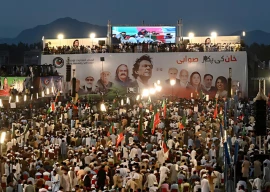
PTI granted permission for Sept 8 rally in Islamabad under 42 conditions
1724268870-0/Supreme-Court-of-Pakistan-(2)1724268870-0-270x192.webp)
Supreme Court reinstates NAB amendments, reverses earlier decision

Sindh govt ‘clarifies’ purchase of luxury vehicles for ACs amid backlash
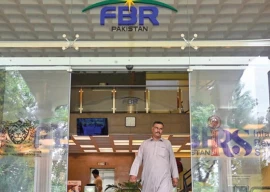
Officers suspended for valid refunds

Contaminated neoliberalism

Our media needs to wake up to the reality of climate change
- Entertainment News
- Life & Style
- Prayer Timing Pakistan
- Weather Forecast Pakistan
- Karachi Weather
- Lahore Weather
- Islamabad Weather
- Online Advertising
- Subscribe to the Paper
- Style Guide
- Privacy Policy
- Code of ethics
This material may not be published, broadcast, rewritten, redistributed or derived from. Unless otherwise stated, all content is copyrighted © 2024 The Express Tribune.
- Science Store
- Online Camp
- DIY Telescope
- Camp's Projects
- Kitchen Science
- Botany Science Fair Projects
- Chemistry Experiments
- Computer Science
- Fun Science
- Science Fair
- Electronics in urdu

Successful alternative sources for power generation (Urdu)
Successful alternative sources for power generation بجلی پیدا کرنے کیلئے کامیاب متبادل ذرائع The article published at technologytimes in Urdu and written by Imran Bahzad. He focus on his article about energy crises of Pakistan and alternate energy resource to solve country problems
Related articles

Best Inventions of 2013 بہترین ایجادات (Urdu)

Dengue fever Includes cause, prevalence, transmission, symptoms, treatment, and prevention in Urdu

Failure of UPS (Uninterruptible power supply) and prevent from failure
Leave a reply cancel reply.
- STEAM Projects
- DIY Projects
- Electronics

The Causes and Consequences of Energy Crisis in Pakistan and Its Solutions
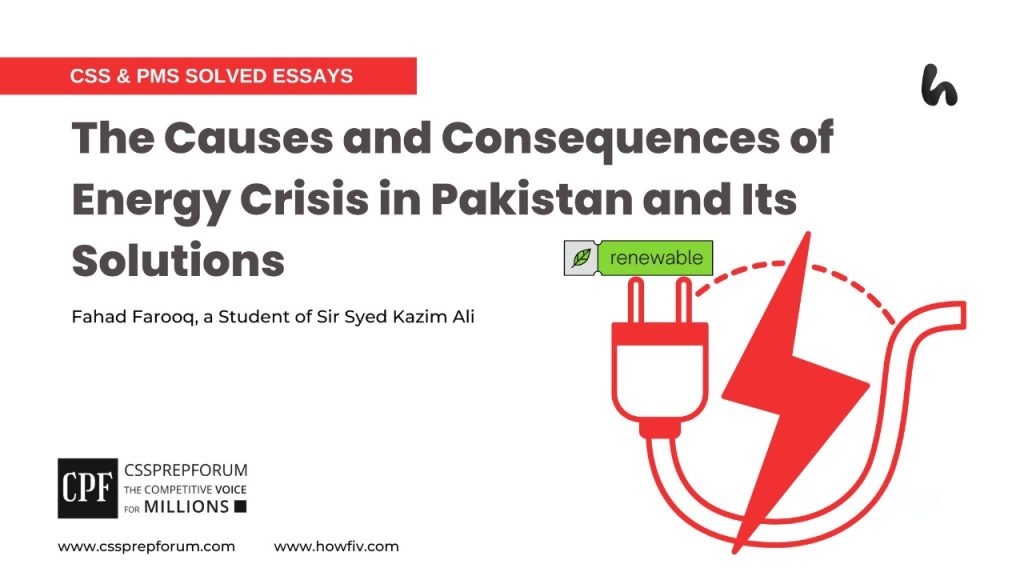
- Fahad Farooq
- December 15, 2023
- CSS Essays , CSS Solved Essays
CSS & PMS Solved Essays | The Causes and Consequences of Energy Crisis in Pakistan and Its Solutions
Fahad Farooq , a Sir Syed Kazim Ali student, has attempted the CSS & PMS essay “The Causes and Consequences of Energy Crisis in Pakistan and Its Solutions” on the given pattern, which Sir Syed Kazim Ali teaches his students. Sir Syed Kazim Ali has been Pakistan’s top English writing and CSS, PMS essay and precis coach with the highest success rate of his students. The essay is uploaded to help other competitive aspirants learn and practice essay writing techniques and patterns to qualify for the essay paper.

1- Introduction 2- Energy crisis in Pakistan: A critical overview
3 – What are the causes of the energy crisis in Pakistan?
- Evidence: Pakistan’s economic conditions constrain the construction of power generation plants.
- Evidence: Lack of policy formulation and implementation due to the unstable political environment
- Evidence: Inadequate transmission and distribution system and overloaded transformers, Report of special committee, Senate of Pakistan 2018
- Case in Point: According to a report published by NEPRA 2018, Pakistan’s energy sector currently has about 25% transmission and distribution losses.
- ✓ Corruption and power theft
- Case in Point: Pakistan is ranked 117th among 180 countries in the Corruption Perception Index, 2018 by Transparency International.
- Evidence: Kalabagh Dam has not been completed due to inter-provincial conflicts.
- Case in Point: Water disputes in Pakistan with India and Afghanistan affect Pakistan’s power sector.
- Case in Point: In 2010, a severe flood severely damaged Pakistan’s power sector.
- Evidence: Reliance on thermal power plants instead of hydel power plants has significantly increased its average cost.
3- What are the impacts of the energy crisis in Pakistan?
- Evidence: Pakistan is suffering from 5 to 12 hours of load shedding per day, which affects the daily routines of students and employees.
- Evidence: Due to high reliance on thermal fuel, circular debt and subsidies provided to the energy sector have increased.
- Evidence: The energy crisis has made the lives of common people miserable.
- Evidence: The unemployment ratio is increasing daily, which is giving birth to other social crimes.
- Evidence: The industrial sector has to cut down its production due to prolonged load shedding and rising electricity bills.
- Evidence: Due to the extreme energy crisis, foreign direct investment in the industrial sector has decreased.
- Evidence: Pakistan has been suffering severe deforestation due to high reliance on thermal sources for power generation
- Evidence: The energy crisis has caused extreme angst among the public, resulting in severe demonstrations against the government.
4- What are the pragmatic measures to overcome the energy crisis in Pakistan?
- ✓ To improve governance and effective implementation of policies
- ✓ To improve the efficiency of power plants and gradation of transmission infrastructure
- ✓ To formulate strict laws to control power theft
- ✓ To utilize renewable sources of energy for power generation instead of fossil fuels
- ✓ To generate electric power from nuclear power plants
- ✓ To build new dams for water storage and settle down inter-provincial conflicts
5- Critical Analysis 6- Conclusion

The energy sector of a country is the foundation of its socio-economic development. Thus, energy security has remained, and still is, the agenda of many developed country’s schemes. However, in developing countries like Pakistan, the energy crisis due to a shortage of energy is the talk of every day. Pakistan has faced operational, managerial, and technical issues in the energy sector for the last two decades. The country has to overcome the crisis to attain socio-economic development in all sectors of society. Bad governance and inadequate planning by incompetent political leaders are the major causes behind the crisis. In addition, electricity losses in transmission lines and consumer power theft significantly burden the country’s economy. This energy shortfall has affected the country’s industrial, agricultural, and economic sectors. As a result, the unemployment, poverty, and social crimes in the society have increased. However, there is nothing in the world that cannot be solved. Pakistan should formulate strict laws and thoroughly implement them to control power theft. Updating the transmission and distribution structure to reduce power losses is essential. Moreover, the government needs to create awareness among the public to use energy-efficient products. In a nutshell, Pakistan’s socio-economic stability is impossible without addressing the issues responsible for the country’s energy crisis. This essay discusses the causes and impacts of Pakistan’s energy crisis and the pragmatic measures to curb the issue.
Currently, Pakistan is suffering from an acute energy crisis. Approximately twenty per cent of the country’s population needs access to electricity. But it does not produce enough energy to meet the demand. There is an electricity shortfall of approximately 8000 megawatts per day; as a result, the population has been facing the haunting effects of load shedding for five to twelve hours per day. This situation reflects the incapability of the previous governments to curb the issue and a need for more implementation of formulated policies in the power sector.
Since every issue has a cause, Pakistan’s poor economic condition is the primary cause of its energy crisis. Huge investments are required to lay the foundation of power projects to attain energy security in the country. Unfortunately, Pakistan has been suffering the worst economic crisis since its inception, due to which the power sector has been neglected. In addition, Pakistan has been facing political instability for decades. According to the Global Economy Watchdog for Political Stability, Pakistan is ranked 192 among 195 countries . In such unstable circumstances, no solid and visionary policy has been formulated to enhance the country’s power generation capacity. As a result, the country’s power sector is facing an acute crisis.
Moreover, most of the projects being used for electricity production are outdated. Due to poor maintenance, these plants operate at an efficiency level much lower than the designed capacity. They consume more fuel and produce less energy; as a result, they tend to increase the circular debt, creating a burden on the federal budget through subsidies. These soaring subsidies have adversely affected the financial health of the economy.
Furthermore, the high loss of electricity in the transmission and distribution system is a significant burden on the country’s energy resources. According to a report published by NEPRA 2018, Pakistan currently has about 25% T&D losses.
Apart from wasting energy, these losses go without payment to the power generation companies, which the government compensates through subsidies. So, these T&D losses significantly drain the country’s economy.
Additionally, corruption in the energy sector and consumer power theft are other significant contributors to the country’s energy crisis. A lack of technology-assisted techniques for stopping power theft has further devastated the situation. Transparency International has ranked Pakistan 117th among 180 countries in the Corruption Perception Index, 2018. Over time, several corruption scandals have been exposed in the power sector, severely affecting its growth and resulting in a high loss to national expenses. In this way, corruption and power theft significantly escalate the country’s energy crisis.
Similarly, inter-provincial conflicts on water sharing in Pakistan have hampered the development of Pakistan’s power sector. Small provinces blame the large ones for not giving their share in water resources. This mistrust has destroyed the understanding among the provinces to cope with the energy crisis. Due to these conflicts, the development of new power stations like the Kalabagh dam could not be possible. Furthermore, Pakistan has also indulged in a water war with its neighbours, India and Afghanistan. Now, India has started building dams on western rivers, and Afghanistan has begun building dams on the Kabul River, which has caused a water shortage for power generation in Pakistan. This has severely affected Pakistan’s power sector.
Another cause of the energy crisis in Pakistan is climate change. Due the phenomenon, heavy rainfalls are becoming very common, which cause floods. These floods damage the country’s electrical power sector every year. For example, the severe flood of 2010 severely damaged Pakistan’s power sector. Due to the lack of dams, this excess water from floods cannot be stored for valuable purposes. Thus, extreme weather patterns due to climate change also contribute to Pakistan’s energy sector disaster.
Lastly, shifting from hydel power plants to thermal power plants has proved another massive drain on the country’s power resources. More reliance on furnace oil to run power plants has made the country more vulnerable to the fluctuation of international oil prices. The current Russia-Ukraine conflict has exposed the vulnerability of various nations, including Pakistan, to oil and gas to meet their energy requirements. In this way, the soaring oil prices in the international markets are badly affecting Pakistan’s energy.
As every crisis comes with some aftereffects, load shedding is considered its most significant effect. This has affected all sectors of society. Due to this, students cannot fully concentrate on their studies, and public and private sector employees need more time in their work. Due to the non-availability of uninterrupted electricity, factories have shifted to other resources like furnace oil and natural gas, resulting in increased production costs. As a result, thousands of employees across the country have been expelled from their jobs. In this way, continuous load shedding has increased the poverty in society.
Due to the lack of solid and versatile policies of the incumbent political leadership, the dependence of power generation on thermal sources instead of hydel energy has increased. This high reliance on thermal fuel has resulted in increased circular debt. The outdated and deteriorated infrastructure of power plants, accompanied by high transmission and distribution losses, has created a massive gap between the supply and demand of electricity. Power plants are consuming more fuel and producing less energy. Moreover, insufficient recovery of bills from consumers has created a massive gap in the costs of generation and payment of recoveries. Instead of increasing the power prices, the government has increased the subsidies provided to the power generation companies. Thus, the energy crisis has significantly burdened the federal budget through subsidies.
The power crisis has made life hell for the majority of the citizens. Frequent load shedding has contributed to the increased unemployment in society. This unpredictable load shedding has caused extreme angst and distress among the public; as a result, various social evils like robbery and street crimes have increased in society. The condition of the youth of the country is especially miserable.
Similarly, the energy crisis has severely affected the industrial and agricultural sectors. They have to cut down their production and lay off thousands of workforce. Factories face early shutdowns, and the employees wait hours to resume work. Consequently, the net output of the industrial sector has decreased. This has resulted in increased prices of fertilizers, pesticides, and other ingredients in the agricultural industry. Moreover, being a water-scarce country, Pakistan’s agricultural sector is highly dependent on the power sector to use underground water for agriculture. Due to frequent shutdowns of electricity and high furnace oil prices, farmers face massive agrarian losses.
Due to the energy crisis, Pakistan is less likely to attract foreign direct investments in industrial sectors. There is a continuous decline in the existing number of industries in Pakistan. Maximum industries have been shifted to foreign countries, where cheap and reliable energy supply is available. Thus, the energy crisis in Pakistan has raised the cost of production.
Pakistan is highly dependent on thermal power plants and has been facing severe deforestation. Due to an unfortunate controversy among the provinces, Pakistan lacks hydel power projects. Besides this, the massive dependency on fossil fuels for electricity production has led to several environmental hazards, such as the emission of GHGs, global warming, and irregular weather patterns. Global warming has been the cause of severe floods in Pakistan for the last two decades, which has badly affected the domestic lives of ordinary people.
The long and often unpredictable hours of load shedding have caused extreme angst among the public, resulting in severe demonstrations against the government. Unfortunately, Pakistan is ranked 192 among 195 countries by the Global economy watchdog for political stability. Due to this political instability, there has yet to be continuance in the formulated policies to overcome the energy crisis in the country.
Every issue has a solution. First, the government should formulate solid laws and thoroughly implement them nationwide. There should be no political involvement in the power sector. The government should mainstream the issue of the energy crisis in the national narrative and try to develop a national consensus on this issue.
Furthermore, the government should focus on increasing the installed power generation capacity. Research centres should be established for prime solutions to power sector problems. The efficiency of the transmission and distribution system should be increased on a priority basis. The government should encourage the distributed generation to reduce transmission and distribution losses.
In addition, technology-assisted techniques must be used to stop power theft. The power sector cannot remain sustainable unless the service cost is fully recovered. The provincial governments and law enforcement agencies should assist the federal government in controlling power theft and the excessive losses in the transmission and distribution system.
Additionally, the country needs to shift from fossil fuels to renewable energy resources for electricity production like wind, hydel, and solar power projects to reduce environmental pollution and resolve the current energy crisis. Pakistan is enriched in hydro-power resources with the potential of 50000 megawatts, which is still untapped. The government should speed up the construction of hydel projects like the Diamer Bhasha Dam and other big projects like Dasu. The country should adopt renewable resources like wind and solar power as soon as possible to shift the trend from fossil fuel generation towards renewable generation.
Moreover, Pakistan should immediately enhance its nuclear power generation as it is cheap and reliable. Pakistan is 6th atomic power in the world but generates only a tiny amount of electrical power from nuclear sources. This will decrease the country’s dependency on foreign technology and imported fuels.
Lastly, being a water-scarce country, Pakistan needs to build more dams to store excess water in the monsoon season and use it in the dry season to run the power plants. For this purpose, the government should immediately settle the inter-provincial conflicts on major power projects, like the Kala Bagh Dam, to include bulk power generation into the national grid and avoid floods. Pakistan should negotiate with India and Afghanistan on critical water disputes as Pakistan’s power sector is highly dependent on the water received from these countries.
The energy sector of Pakistan has been facing an acute crisis for the last two decades due to incumbent political leadership, lack of formulation of solid policies and other technical issues. The situation has hampered Pakistan’s socio-economic development. With a dwindling economy and soaring political instability, the country needs immediate pragmatic steps to curb the issue for the smooth running of all the state’s sectors. If this issue is not resolved on a priority basis, the situation will become worse. In conclusion, the prolonged energy crisis has devastated the national economy. It has slowed down the industrial sector and affected all life sectors. It has caused inflation, unemployment, and poverty in the society. It has also damaged Pakistan’s international image. Multiple reasons behind the crisis, like poor governance, outdated power plants, transmission and distribution losses, power theft, inter-provincial conflicts on water resources and high dependency on thermal sources, need an immediate response from the government. And the adoption of renewable technologies can tackle the issue of outdated plants, reducing power losses, and implementing effective policies.

CSS Solved Past Papers’ Essays
Looking for the last ten years of CSS and PMS Solved Essays and want to know how Sir Kazim’s students write and score the highest marks in the essays’ papers? Then, click on the CSS Solved Essays to start reading them. CSS Solved Essays
CSS Solved General Science & Ability Past Papers
Want to read the last ten years’ General Science & Ability Solved Past Papers to learn how to attempt them and to score high? Let’s click on the link below to read them all freely. All past papers have been solved by Miss Iqra Ali & Dr Nishat Baloch , Pakistan’s top CSS GSA coach having the highest score of their students. General Science & Ability Solved Past Papers
Articles Might Interest You!
The following are some of the most important articles for CSS and PMS aspirants. Click on any to start reading.
Recent Posts

Top Categories
Cssprepforum, education company.

cssprepforum.com
Welcome to Cssprepforum, Pakistan’s largest learning management system (LMS) with millions of questions along with their logical explanations educating millions of learners, students, aspirants, teachers, professors, and parents preparing for a successful future.
Founder: Syed Kazim Ali Founded: 2020 Phone: +92-332-6105-842 +92-300-6322-446 Email: [email protected] Students Served: 10 Million Daily Learners: 50,000 Offered Courses: Visit Courses
More Courses

Basic English Grammar and Writing Course
Extensive English Essay & Precis Course for CSS and PMS

CSS English Essay and Precis Crash Course for 2023
Subscribe to our mailing list to receives daily updates direct to your inbox.

- CSS Solved Essays
- CSS Solved GSA
- CSS Solved PA
- CSS Solved Islamiat
- Current Affairs
- All Courses
- Writers Club
- All Authors
- All Members
- All Teachers
- Become an Author
- Who is Sir Syed Kazim Ali?
- Privacy Policy
CssPrepForum is Pakistan’s largest and greatest platform for CSS, PMS, FPSC, PPSC, SPSC, KPPSC, AJKPSC, BPSC, GBPSC, NTS, and other One Paper 100 Marks MCQs exams’ students. It has become Pakistan’s most trusted website among CSS, PMS students for their exams’ preparation because of its high-quality preparation material.
@ 2023 Cssprepforum. All RightsReserved.


IMAGES
VIDEO
COMMENTS
Welcome to "The Essay Series" by Mansoor Saleem! In this episode, we will shed light on a critical issue that affects millions of residents: the energy crisi...
Essay on Energy Crisis in Pakistan - 500 Words. Pakistan is currently facing an energy crisis that has severely impacted the country's economic and social development. The crisis is characterized by a shortage of electricity and natural gas, leading to prolonged power outages and gas load shedding.
The current energy crisis began to manifest itself in earnest by late 2007. Although the causes of the crisis are structural, the immediate trigger was the 2007 global commodity price boom, when oil prices almost tripled over an 18-month period.1 The unprecedented fuel inflation was a key factor in the 36% increase in Pakistan's import bill ...
In recent decades, Pakistan has been grappling with a severe energy crisis that has had far-reaching consequences on its economy, society, and environment. This essay delves into the intricacies of the energy crisis in Pakistan, its root causes, and the profound impact it has on the nation. Moreover, it outlines potential solutions, examines ...
If current gas policies persist, Pakistan's natural gas supply is expected to decline from 4 billion cubic feet per day (bcfd) in 2010/11 to less than 1 bcfd by 2025/26. This will lead to a ...
Essay On Energy Crisis In Pakistan (200 words) Pakistan faces a severe energy crisis due to a lack of resources, poor management, and an inefficient distribution system. The country is heavily dependent on imported oil, which has led to high costs and volatility in energy prices. This has resulted in frequent power outages and load shedding ...
The global energy crisis, arising from a demand-supply imbalance exacerbated by natural disasters, political instability, economic growth, and technological changes, is currently intensified by the post-COVID-19 economic recovery, the war in Ukraine, and diverse weather conditions. This crisis is notably impactful in Pakistan, marked by ...
Complete and clear explanation about energy crises in pakistan essay css in urdu or energy crises problems and solutions or energy sector of pakistan or ener...
iv Solutions for Energy Crisis in Pakistan Acknowledgements T his volume is based on papers presented at the one-day National Workshop on the topical and vital theme of Solutions for Energy Crisis in Pakistan held on December 17, 2014 at Marriott Hotel, Islamabad. The Workshop was jointly organised and financed by the ...
March 13, 2013. An acute ongoing energy crisis poses serious threats to Pakistan's feeble economy and national security environment. Michael Kugelman (Woodrow Wilson International Center for Scholars) examines the origins of the country's energy problems, prevailing hurdles to reform, and potential impact of the upcoming general elections.
d) Public trust erosion. Check Also: Essay Outline: Economic Crisis in Pakistan: Challenges and Prospects. 6. Recommendations. 6.1 Short Term Measures (Within 6 months to 1 year) a) Resolution of circular debt. b) Prompt implementation of NEPRA determined Tariffs. c) Ensuring recovery of revenues from public sector.
Essay On Energy Crisis In Pakistan (200 & 500 Words)-1 - Free download as PDF File (.pdf), Text File (.txt) or read online for free. Pakistan is facing a severe energy crisis characterized by shortages of electricity and natural gas that have led to prolonged power outages and gas load shedding. This energy crisis is the result of poor management of the energy sector, insufficient investment ...
In this context, the adoption of alternative energy sources presents a compelling solution to address Pakistan's energy crisis. Pakistan's energy crisis is a long-standing and multifaceted issue that has significantly impeded the country's economic growth and development. Pakistan witnessed acute energy crisis during the summer months ...
There are many interconnected and overlapping causes behind the crisis in Pakistan. Lack of political will and consistent pragmatic energy policies; economic instability and the lack of technical ...
Case in point: According to the Pakistan's ministry of energy and the Oil and Gas Regulatory Authority, energy-deficit Pakistan imports approximately 430,000 metric ton (mt) of motor gasoline, 200,000 mt diesel and 650,000 mt crude oil at a cost of $1.3 billion/month. 5- Root causes behind the energy crisis in Pakistan.
Complete explanation about energy crisis in pakistan essay css in urdu or energy crisis problems and solutions or energy sector of pakistan or electricity cr...
February 6, 2023 3:00 pm (EST) Worsening blackouts are the latest manifestation of Pakistan's economic distress. A brewing debt crisis could plunge the country into financial chaos. A wave of ...
سائنس, ٹیکنالوجی ارٹیکل اردو میں. by Abdul Rauf. Can We Solve The Energy Crisis With Solar Power Article کیا شمسی توانائی سے بجلی کا بحران حل کیا جاسکتا ہے؟ written by Mian Mohammad Ishfaq and published at technologytimes weekly news paper. 0.
Research has revealed that Pakistan has a maximum gas supply of 4,300 million standard cubic feet per day (mmcfd) against the average demand of 6,500 to 7,000 mmcfd. During the winter season, the ...
Successful alternative sources for power generation (Urdu) Successful alternative sources for power generation بجلی پیدا کرنے کیلئے کامیاب متبادل ذرائع The article published at technologytimes in Urdu and written by Imran Bahzad. He focus on his article about energy crises of Pakistan and alternate energy ...
Another cause of the energy crisis in Pakistan is climate change. Due the phenomenon, heavy rainfalls are becoming very common, which cause floods. These floods damage the country's electrical power sector every year. For example, the severe flood of 2010 severely damaged Pakistan's power sector.
Energy Crisis In Pakistan | Rupiya Paisa | 11 Sep 2024 | Abbtakk News#EnergyCrisis #RupiyaPaisa #Abbtakk #abbtakkheadline #abbtaklive #abbtakknews #abbtakk...